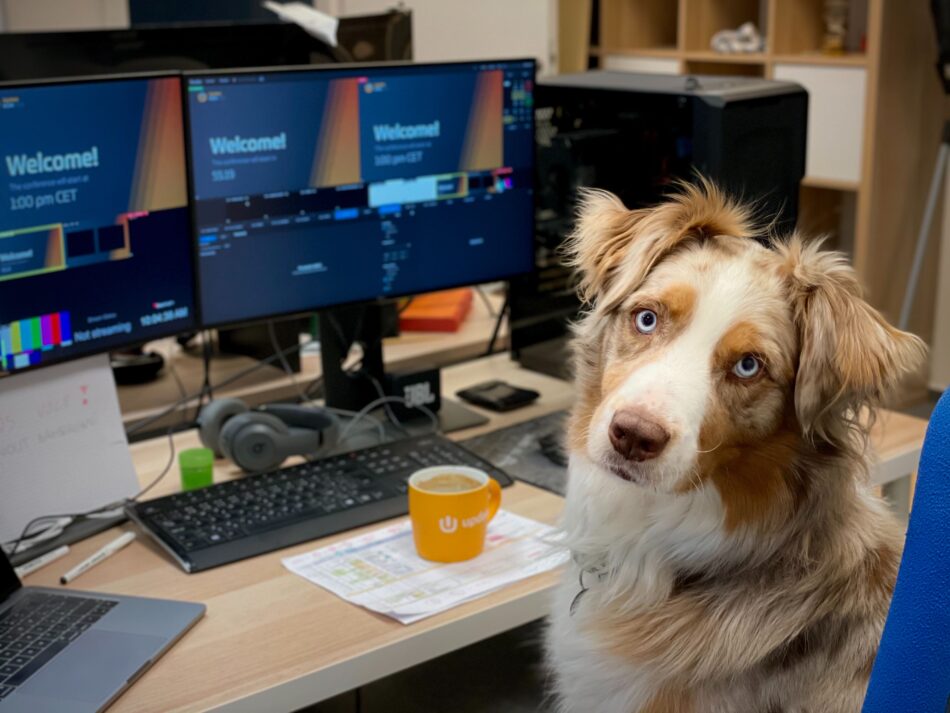
Did you know that having dogs in the office has been shown to boost morale, with employees who come into contact with dogs at work having higher job satisfaction than average? Bringing your dog to work can also reduce stress levels, and stroking a dog can lower both your heart rate and your blood pressure. In Australia, National Take Your Dog to Work Day is celebrated on the last Friday of June. So, if you’ve been given the go-ahead from your workplace, keep reading to make sure your pup’s day at the office goes smoothly.
Is your dog ready?
Bringing your dog to work may seem exciting, but before making concrete plans, be sure to put their needs first and assess whether they’re truly ready. Not all dogs are suited for a full day in the office, and to make sure you both enjoy it, you’ll need to consider a few factors.
First, think about their temperament. If your dog becomes anxious and overwhelmed in new settings, then the buzz of a busy office all day won’t be the best place for them. Or perhaps they love being sociable and exploring new places. That’s a great start, but you should ensure their basic dog training is up to scratch so that they can keep calm and not disrupt your or your colleagues’ day at work.
Preparation is key
If you’ve decided that your dog is workplace-ready, then it’s time to begin thinking about what you’ll need to take with you for the day. If your dog is crate trained, be sure to bring their dog crate along with you. This will offer them somewhere safe, secure, and familiar they can retreat to, should they want some alone time. Similarly, you should pack their dog bed as a reminder of home and a comfy spot for them to get some rest on.
Dog water and food bowls are also essential, and don’t forget the treats! Plus, puzzle toys like Kongs are great for keeping your dog occupied while you make a phone call or need to be focusing on work.
How do your colleagues feel?
Even if you’re confident that your dog won’t cause any problems around the office, you might have colleagues who are afraid of or allergic to dogs. It’s your responsibility to speak to people in the workplace to find out any reservations and make accommodations to suit.
Compromise goes a long way
Don’t feel overly pressured to bring your dog in on the day that National Take Your Dog to Work Day falls. It might be a case that you have too many meetings on that day, or you know you’ll be working overtime. If you’ll be unable to meet the needs of your pup then there’s nothing wrong with rearranging. Speak to your colleagues about a better day to suit everyone and their dogs so that the occasion can be as stress-free as possible for everyone.
Make time for walkies
It’s a good idea to get your four-legged friend out on a long dog walk before bringing them to the office. This way, they’ll have had time to exert some of their energy, and should hopefully be okay for a few hours without a toilet break.
During the day, you’ll want to make sure you have time during your lunch break to get your dog out on another walk, plus a few shorter breaks for them to stretch their legs. A walk at lunchtime will benefit you as well as getting some fresh air will improve both your mood and your productivity. Don’t forget a matching designer dog collar and lead set when you’re heading out too, so that you can celebrate the day in style!
What’s your plan B?
You know your dog, but a new environment might cause them to react in a way unlike their usual self. Barking or altercations with other dogs can be stressful for everyone involved (two and four-legged!), so make sure you have a backup plan before the day begins. Perhaps you’re able to take your dog home, or maybe there’s a spare meeting room the two of you can retreat to. Communicate with the organiser of the event to see what options are available.
Also, keep an eye out for any sign that your dog is stressed or anxious. These include panting, licking their lips and yawning to name a few.
Omlet and your dog
Bringing your dog to work can be a great day for both you and your pet but you definitely don’t want them to be a reason your colleagues start to get annoyed with you. Ultimately, preparing your dog and taking full responsibility is key and with the help of Omlet dog products such as dog crates and dog beds, your furry friend’s day out can be made even better.
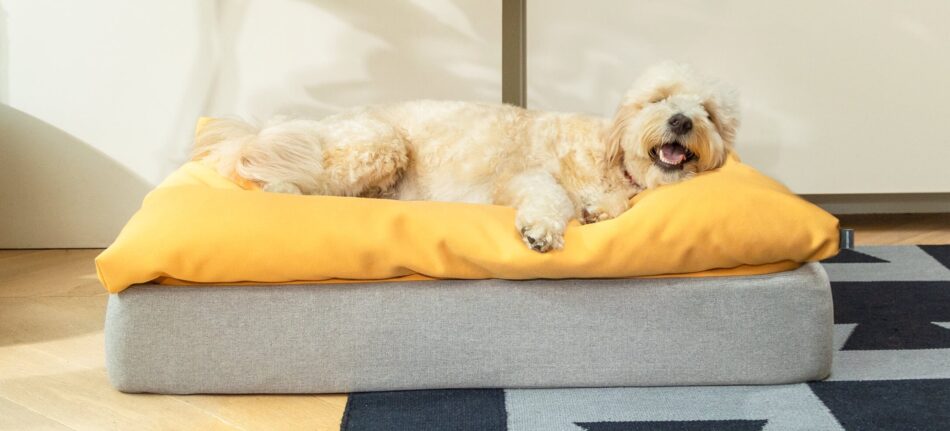
This entry was posted in Dogs
Most dog owners will know when their dog’s birthday, or “Gotcha Day” is, but what do you do to mark the occasion? Well, if you’re looking for the pawfect excuse for a party, why not celebrate your pup’s big day? Here’s how you can throw a dog birthday party in style!
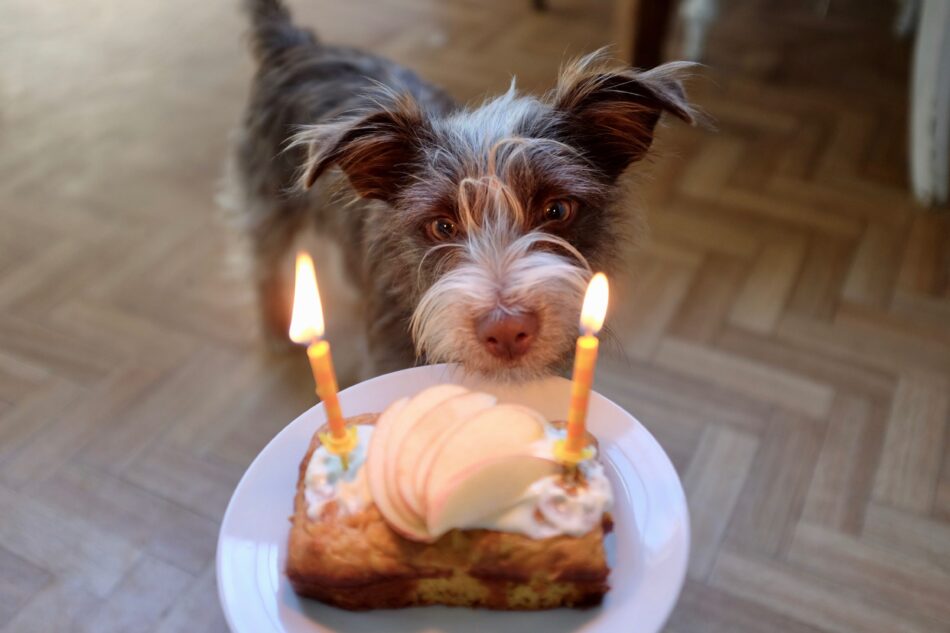
Dog birthday party ideas
Party checklist
Everything you need to do before the big day to guarantee your pawty is a success!
- Send invites to all your dog’s favourite pups and people
- Buy and set up decorations, e.g. number balloons, animal balloons, bunting, dog-friendly party hats.
- Bake a delicious “pup-cake”
- Buy and bake other party treats for both human and canine guests
- Prepare your party games
- Set up a playlist
- Fill a few bowls of water, and have poop bags on hand
Birthday pupcake
Of course the birthday boy or girl deserves a birthday treat. This grain free peanut butter pupcake contains only 4 ingredients, but will no doubt impress both two and four legged friends!
Ingredients
1 egg
3 tablespoons peanut butter (make sure it’s sugar and salt free and contains no xylitol)
1/2 apple, grated or finely chopped
1/2 teaspoon baking powder
Instructions
- Preheat oven to 350 degrees Fahrenheit
- Combine all ingredients in a bowl
- Grease a muffin tin or a ramekin and pour in the batter
- Bake for approximately 20 minutes
- Let cool in the container for a few minutes, then remove. Let the “pup-cake” cool completely before serving to your dog.
Decorate with your dog’s favourite treats. How about some Greek yogurt? Maybe some more peanut butter? Finish off with an apple slice or sprinkle some dog treats on top.
Recipe from http://www.spoonfulofsugarfree.com/2012/05/01/grain-free-peanut-butter-apple-doggy-cake/
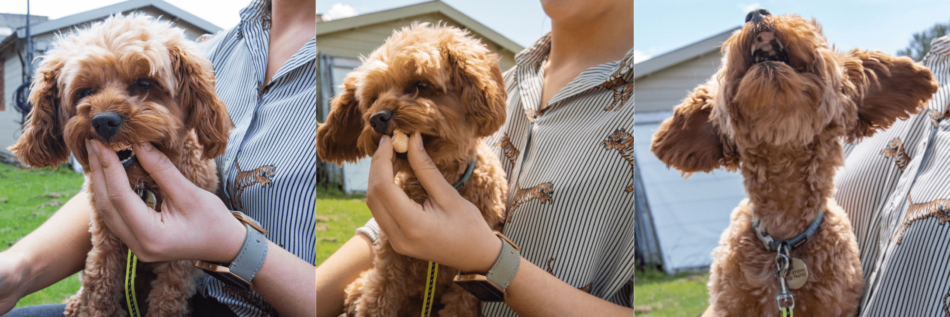
Easy dog biscuits
Impress your guests with another delicious homemade treat that won’t take you all day to make!
Ingredients
3 cups of all purpose flour
2 eggs
⅓ cup of water
Instructions
- Preheat oven to 350 degrees Fahrenheit
- Combine all ingredients in a bowl, and form a stiff dough with your hands.
- Add more water if necessary to achieve dough-like texture
- Dust some flour on a clean surface, and roll out dough to a ¼ inch thick
- Cut out desired shapes (we used bone shaped cookie cutters) and place on a baking tray lined with greaseproof paper
- Place in oven for 15-20 minutes
Why not try adding some finely chopped apples, bananas or carrots to your biscuit dough before rolling and baking?
Recipe from: https://theblondcook.com/simple-dog-biscuits/
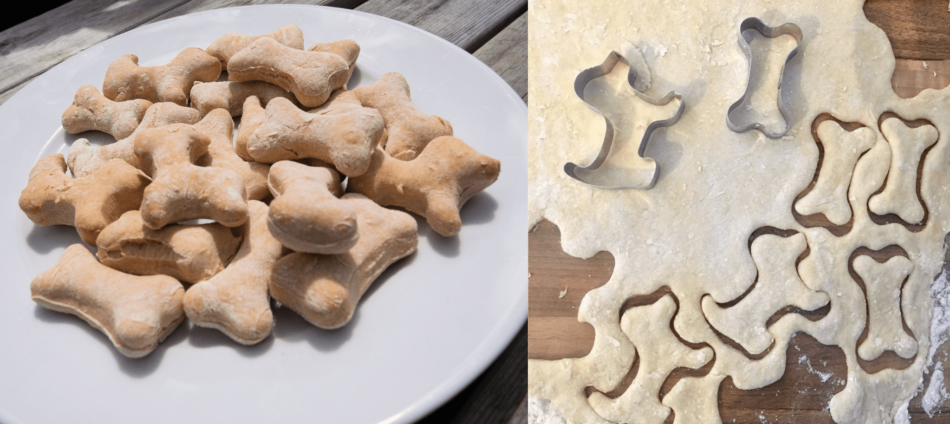
Pawty games
Even if running around and playing with friends will probably be enough to keep your pup happy you might want to plan a few games that both dogs and owners will enjoy, and that will hopefully keep four-legged party-goers out of mischief.
Catch the treat
If possible, make the dogs stand in a row with their owners a meter or so in front of them. The owners will throw 10 dog treats to their pets, and the dog that catches the most wins.
Party tricks
For this one you will need a judge to decide who’s got the best party trick up their sleeve. Alternatively you can choose a few commands and see who will get the most right in a minute, or who will finish the commands first. If fido hasn’t quite mastered enough tricks yet, take a read of 5 Tricks To Teach Your Dog blog for some inspo!
Musical chairs
Place mats or similar markers in a circle, one less than the number of party pups. With the dogs on the lead, the owners walk around the mats while the music is playing. When the music stops, owners will need to bring their dog to a mat and make them sit nicely. The couple without a mat is out of the game. Remove one mat at a time until you have a winner!
Fetch
This game is best played outside with plenty of space. Owners stand with their dogs and throw a toy on a given command. The first dog to return with the toy is the winner.
Puzzle game
Cut a cross in old tennis balls and put a treat in the ball. Give the dog one ball each. The first one to work out how to get the treat out wins.
Pawty bags – dog birthday party supplies
All the best hosts give their guests a little something to remind them of the fun that was had and thank them for coming! Take a look at our favourite party bag suggestions for canine guests…
- A little bag of your homemade dog biscuits
- A nice plush toy
- Tennis balls
- Dog treats
- A balloon
- A stylish doggy bow or bowtie
- A frisbee
- A bone
- Poop bags
Pup playlist
A party isn’t complete without the perfect playlist for your guests to enjoy. From the party favourite “Who let the dogs out” to anxiety-reducing melodies, take a look at our dog-lover’s Spotify playlist here:
Just because the party’s over, doesn’t mean that the fun has to stop! Shop Omlet dog products to find everything your furry friend needs to have a great time all year round!
This entry was posted in Dogs
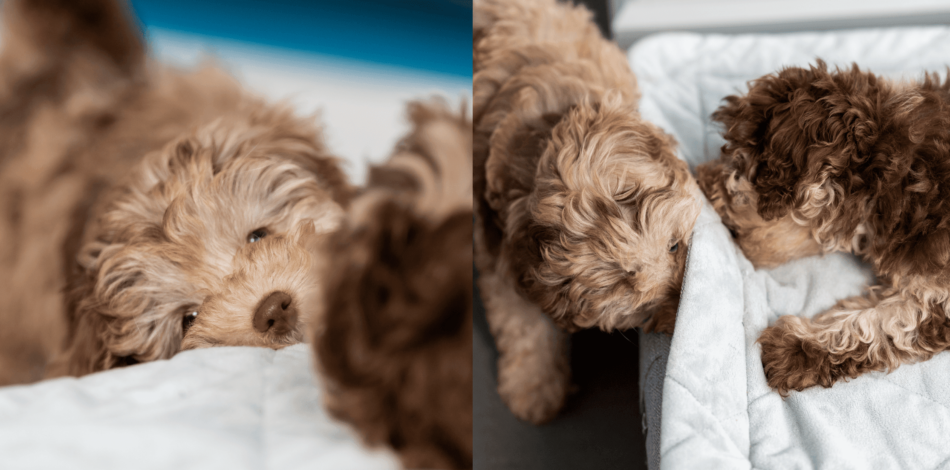
Bringing home a puppy is a very special time for everyone involved. And as with welcoming any new family member, your tiny, furry addition will inevitably change the dynamic of your household. With that, may come a few bumps in the road, also known as puppyhood. It’s important not to forget that as exciting as this time can be, it can be quite a daunting experience for you and your puppy. But, seeing the exciting world through the lens of your new forever friend makes the first few restless nights and teething issues all worth it. Here are our top tips for the first week with a puppy.
Take some time off work
Once you know when you’ll be collecting your puppy, it’s wise to take at least a week off work to stay at home. The first week will be a learning curve for you and your puppy, so it’s a good plan that you spend this time together building a bond, establishing a routine, and of course, having fun. It’s also an opportunity to start toilet training with your puppy, and since dogs of this age need to go potty a lot more frequently than their adult counterparts, you’ll need to be on hand to let them in and out of the home.
You should also have considered what your arrangements will be after the first week off work with your puppy. Will you be available to frequently check in on them? Is your partner going to be working from home? Most puppies under 10 weeks old can’t hold their bladders for more than an hour, so you should think about whether you’re able to make this big commitment with your current lifestyle. Fortunately, many workplaces are now dog friendly, so this might be an option for you as your puppy gets older.
First impressions count
The first few days with your puppy are crucial for establishing a strong and positive relationship with your pet. Take the time for everyone in the household to interact with your dog; playing, cuddling, and stroking them. Your new puppy may also be a little weary of you, to begin with. Be very gentle when you’re handling them and slowly you’ll be able to develop their trust in you and become familiar with your touch, voice and scent. Introduce them to a couple of dog toys and reward any good behaviour with dog treats.
Once the news gets out that you’re getting a puppy, friends and family are bound to want to visit, but take it slowly. Socialization is key to having a well-rounded dog but there will be plenty of time for others to meet your new furry friend. Introduce people to your puppy gradually and don’t forget that your pup shouldn’t be interacting with unvaccinated or unknown dogs, as well as visiting areas by freshwater, areas that are known to have a rodent infestation, or anywhere that unvaccinated dogs could have visited until they’re fully vaccinated themselves.
Be consistent with feeding time
Dogs love routine, so to maintain as much consistency as possible, it’s wise to follow the same diet as the breeder or rescue was feeding the litter. This is especially important while your puppy is already navigating a confusing change to their environment. Find out as much information as possible before you go to collect your puppy, so you have time to research and purchase the appropriate food. Once your puppy is home, follow the diet as closely as you can, and if transitioning to a different type of food, do so gradually to avoid upsetting their sensitive stomachs.
Find a dog bed that will stay with them forever
Puppies sleep…a lot. In fact, they can spend up to 20 hours of their day snoozing away but after a day filled with zoomies and making mischief, it’s hardly surprising they need somewhere super comfortable to get some shuteye. It might be tempting to let your dog sleep on your bed, especially with their irresistible puppy eyes but in the long run, they’ll thank you for providing them with a bed designed just for them.
Omlet’s Topology Dog Bed was built to last. With a memory foam mattress base that moulds to the shape of your dog and a choice of removable toppers for you to easily wash clean, the Topology is what dog bed dreams are made of. For puppies, The Quilted topper is perfect, made from an ultra-durable, hard-wearing material that even razor-sharp puppy teeth can’t rip through. Plus, you can even add a puppy pad beneath your topper for an extra layer of confidence.
Getting your puppy’s bed right in the first week means that they’ll soon associate it with their safe space from a young age. And since you can choose from 3 sizes, you can find the perfect fit for when your dog is fully grown. This bed will truly take your four-legged friend through from puppy to prime.
Use a crate
Dog crate training is invaluable, and can be started during your puppy’s first week at home. Since you’ll be unable to monitor your puppy’s every move day and night, using a dog crate to use for short periods of time means that you’ll be able to keep them out of harm’s way when you cannot be with them. Dog crates are also a very useful training tool, and provide nervous puppies with a den they can call their own.
You can even add a dog bed, super soft puppy blankets and a couple of dog toys to your puppy’s crate to create a cosy space. As your puppy gets older and begins travelling in the car, you can even take their crate with you so that they’re secure and safe on their journey.
Omlet and your puppy
We’re committed to bringing people closer to their pets, which is why we designed and carefully crafted the Omlet Topology Bed and dog crates with puppies in mind. The joys of puppyhood also come with a few challenges but with this advice and Omlet’s innovative products, the first week with your new puppy can be made as stress-free as possible.
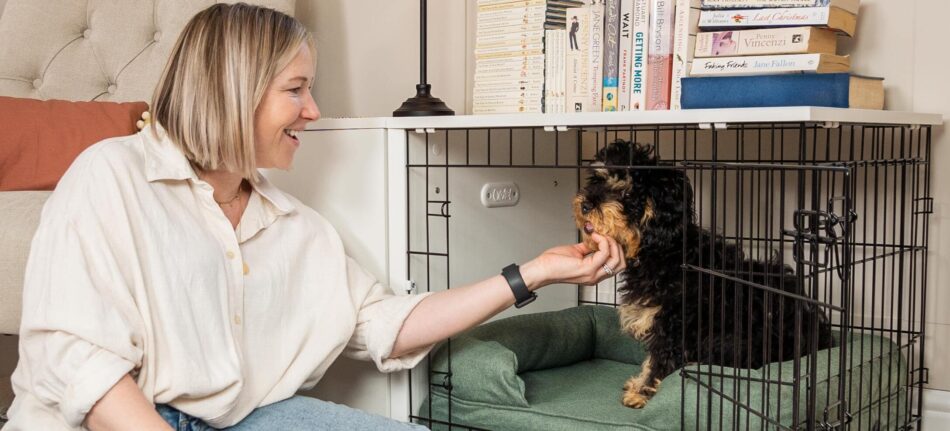
This entry was posted in Dogs
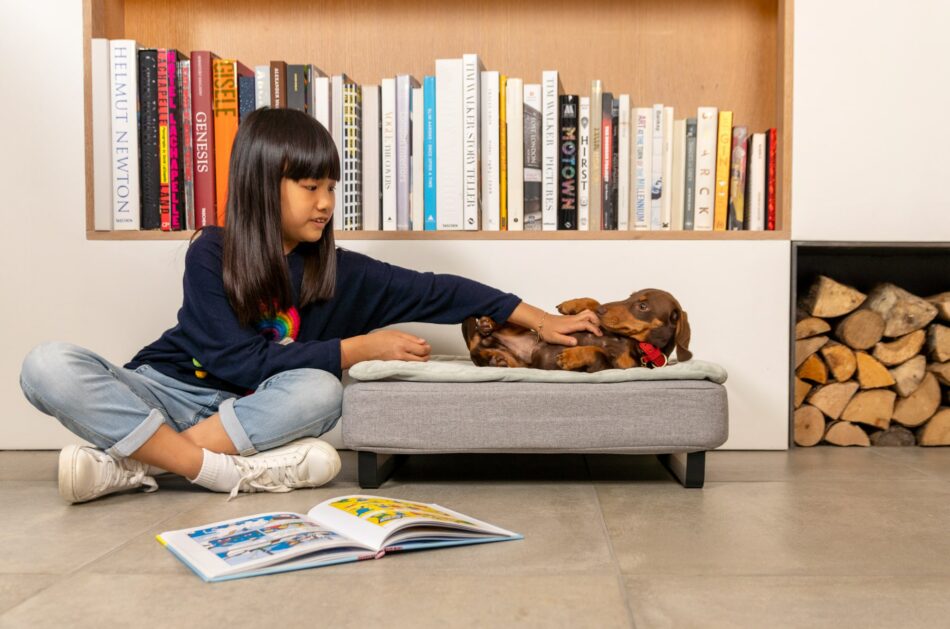
The bond between man and dog is a profound connection that dates back centuries. As every pet parent knows, our four-legged friends often communicate their affection through subtle, yet unmistakable signs. From tail wags that speak volumes to those soulful gazes that melt your heart, our canine friends possess a unique language that expresses love in ways beyond words. Understanding these signs not only strengthens your bond together, but deepens your appreciation for the companionship that dogs bring into our lives. Join us as we explore and reveal the 8 signs that your dog loves you.
1. Tail-wagging welcomes
There’s nothing quite like the exuberant, tail-wagging embrace you receive from your dog when you enter your home. Whether you were gone for 5 minutes or all day at work, their excitement to see you is heard in every joyful bark and seen in every ecstatic spin. It’s as if they’re saying, “You’re home! I miss you so much!”. This genuine delight that we see in our dogs when we arrive home is a testament to their love for us, and with such a warm welcome waiting, the bond between us and them can only deepen daily.
2. Doggy deep breaths
We know that yawning is contagious between humans, but did you know that studies show that dogs are more likely to yawn simultaneously with their owners than with someone they don’t know? It’s suggested that this is a way for dogs to show empathy, and that yawning together with their owners is a sign of affection. For dogs, yawning in the presence of their beloved humans is most often a sign of relaxation and a demonstration of their deep connection with you. But sometimes, your dog’s yawns can be indicative of stress – so make sure you can distinguish their accompanying body language. The next time your pup stretches their jaws with a relaxed body and lets out a yawn, take it as a heartwarming “I love you” in their language.
3. Love licks
Ever noticed how your dog gives you a big, slobbery smooch when you least expect it? Well, that’s no accident! For dogs, licking isn’t just about cleaning themselves or for tasting – it’s one of the strongest ways for dogs to show their pure, unadulterated love. It all goes back to puppyhood. Puppies lick their mother’s face to communicate their needs and show affection and this behavior continues into adulthood.
When your pup plants a wet kiss on your hand or face, they’re not just clearing any leftover crumbs from dinner; they’re bonding with you! So if your dog showers you with licks, just embrace it. The slobber can be wiped away but the fact that your dog thinks you’re the best thing since bacon-flavored treats is irreplaceable.
4. Puppy presents
When your dog brings you their favourite chew toy or nudges their treasured ball in your direction, it’s not just an invitation to play – it’s a declaration of love. Dogs are inherently social animals and they view their humans as part of their pack. So, naturally, sharing their beloved dog toys is a way to foster unity and create a connection. Whether it’s a squeaky plushie or a weathered rope, the act of sharing their toys is your dog’s sign that they trust and adore you. So the next time your furry friend plops their favourite toy on your lap, engage with them and show them you love them just as much.
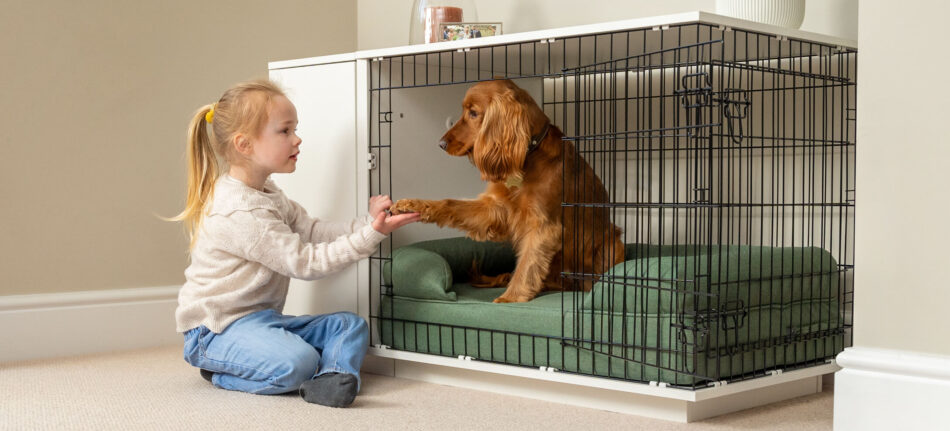
5. Scent masters
Did you know that dogs possess an extraordinary sense of smell that is 10 to 100 times more acute than that of humans? They use this superpower to not just find their toys or detect treats but also to form deep emotional connections. For dogs, everything has its own unique scent – including you. And since you’re their person, they recognize your specific smell amidst a sea of all others because of the emotional attachment they have to it.
You might get a bit annoyed when your pup steals your underwear and runs around the house with them, but try to remember that this thievery is actually a strong sign of affection. It means that your dog wants to feel close to you even when you’re not right next to them. So if you see your dog doing this, leave an old T-shirt in their bed when you’re out of the house to help make them feel safe.
6. Puppy dog eyes
When it comes to non-verbal communication, dogs are the masters. If you’ve ever caught your dog staring at you it’s likely not just a casual glance. For dogs, maintaining eye contact is their way of telling you that they love you. In fact, eye contact releases the hormone oxytocin in the brain, which triggers feelings of comfort and affection, ultimately creating a stronger bond between you and your canine companion. And what’s even more interesting is that this silent way of showing affection is usually only reserved for their people. Dogs don’t use eye contact in the same way within their own species and prolonged eye contact between two dogs can actually be a sign of aggression.
7. Love lounging
There are several ways your dog can use body language to show that they feel completely comfortable in your presence. When dogs exhibit relaxed body language, it’s a remarkable display of their deep-rooted love and affection towards you. With a loose stance, ears in a neutral position, and a slightly open mouth, your dog is signifying total comfort and ease in your relationship. Your dog can literally make its body be a reflection of affection for you, which is a testament to their unbroken trust in you.
8. Canine comfort
In the wild, dogs sleep huddled with their pack for warmth and security. But through domestication, you’re the only pack they have, so you may find your furry friend choosing to snuggle up next to you instead. When allowed to, dogs will sleep as close to their beloved humans as possible, both to feel protected and to protect the people they love the most – which is you. In a similar way, dogs also show you their love by staying close to you when they are feeling stressed or intimidated.
While we all love a good snuggle with our pets, when it’s time for them to nap or sleep for the night, it’s important to find them a dog bed that suits your canine’s comfort needs. The Omlet Topology Dog Bed is the perfect snuggle substitution with its customisable toppers that can be paired with your dog’s specific sleep style. Every snuggle is special and we designed the Topology Dog Bed to reflect that.
Omlet and your dog
From wagging tails to soulful gazes, one thing remains clear – our dogs can speak volumes through their unspoken language of love. At Omlet, we amplify these heartwarming connections through our products that bring you and your pet closer together. Identifying the signs your dog is sending to show you their love is easy. Meeting them with the same unconditional love in return is the “why” behind all of Omlet’s designs and creations like the Topology dog bed and dog crates. After all, the bond between human and canine is as old as time and one that should be celebrated.
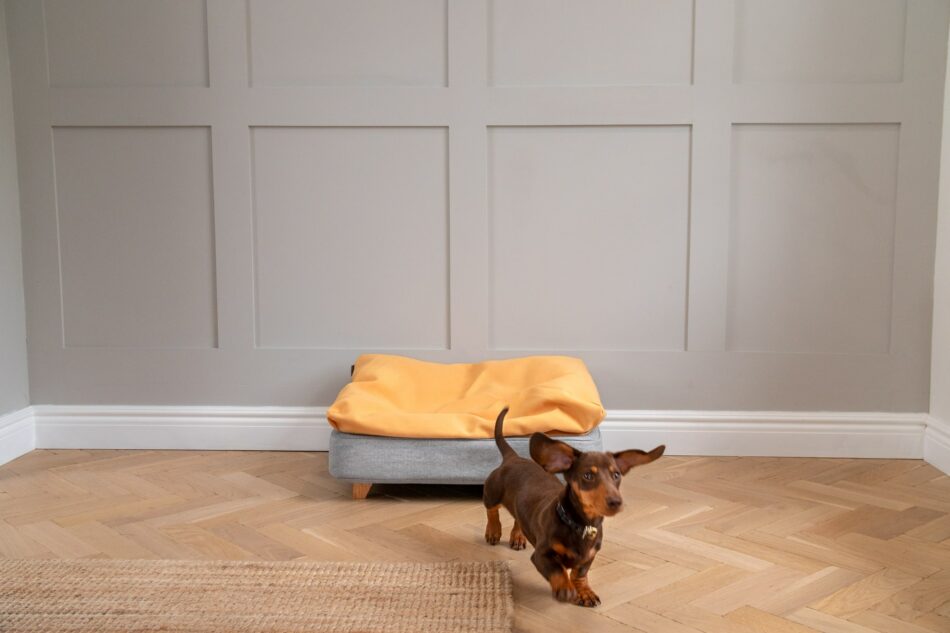
This entry was posted in Dogs
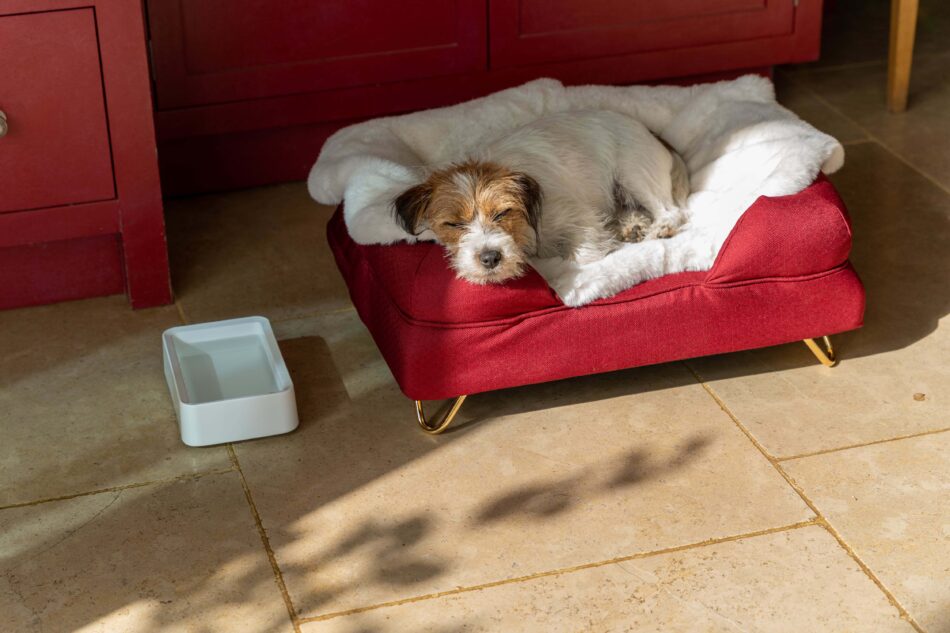
For most pet dogs meal time isn’t very challenging time of the day. Typically owners only put the food bowl down and leave them to it. If this suits you and your dog that’s absolutely fine, but they would without a doubt not have been served food in this way in the wild. Instead they would have had to scavenge and hunt for their meals, keeping both mind and body active. If you feel like you would like to challenge your dog and enrich their daily routine, then making some changes to their meal times can be a good start.
Adding more mental stimulation to your dog’s life can have several benefits. It keeps them busy and tires them out in a similar way to a long walk. Many dog owners forget about challenging their dogs mentally, and when they encounter problems with boredom and linked behavioural issues like chewing, pacing, jumping and barking, they just presume they need to increase the physical exercise. This helps, but it doesn’t satisfy your dog’s hunger for mental stimulation.
Mentally stimulated dogs are not as hyperactive, and they tend to adapt more easily to stress. This is useful if you’ve got a very worried pup who shows aggression towards other dogs walking past the house, struggles with separation anxiety or gets stressed during thunderstorms or fireworks.
Brain games are therefore a brilliant way of tiring your dog out for the evening, or before you leave for work in the morning. By combining this with their normal feeding time, it won’t take much longer than normal, and your dog will love the extra challenge. Additionally you don’t have to worry about giving your dog too many treats as they are rewarded with food they would have eaten anyway.
So what are some fun ways of mentally stimulating your dog during meal times?
The aim is that it should take your dog 10-15 minutes to finish their food. Make sure you supervise your dog the first few times you’re trying a new way of feeding.
Our first tip is nose work. Using their nose comes naturally to dogs, and searching for their food will definitely add stimulation to their daily routine. Scatter the food in the garden so that your dog will have to sniff around to find it. You can also do this indoors, but it might be good to choose a room that’s easy to clean and where the pieces of food won’t get stuck under furniture. If you want to make it even more challenging you can hide little heaps of food under a bush, on a window sill or behind some flower pots. If your dog doesn’t get the game, start with something that smells a bit more than their normal dry food.
Our second suggestion is puzzles and food dispensing toys. The Classic Kong is the most well known food dispensing toy, but you can also find treat balls and complicated puzzles that provide your dog with a harder challenge before they are rewarded with food. The idea with most of these is that your dog will have to move the toy around the floor or press certain parts of the toy to make the food fall out. Dogs absolutely love this, and as they get rewarded again and again it can keep them entertained for hours.
If you don’t want to buy toys you can make some yourself. Try putting the food in a cereal box and taping it shut, in a toilet roll with folded sides, or in a plastic bottle with some holes cut out where the food can fall out. This can get a bit messy, and definitely noisy, but it’s worth it when you see your dog running around trying to get into the box, tail wagging with excitement.
You can also use mealtime as an opportunity to practice tricks and teach your dog new ones. Don’t ask your dog to do the same tricks every meal time, as it will just become a part of the routine, and not challenging or mentally stimulating. By using this time for training you are able to give your dog more than just the one treat at a time, as it’s the food he or she is supposed to eat anyway. This will form a stronger positive association, and your dog might learn faster.
Another thing you can do to change the daily routine is to change the texture of the food. If your dog normally gets wet food, try freezing it into little discs or cubes that they will love crunching on. If your dog gets dry food you can mush it up with a bit of yoghurt or water. It’s all about novelty and enriching your dog’s daily routine!
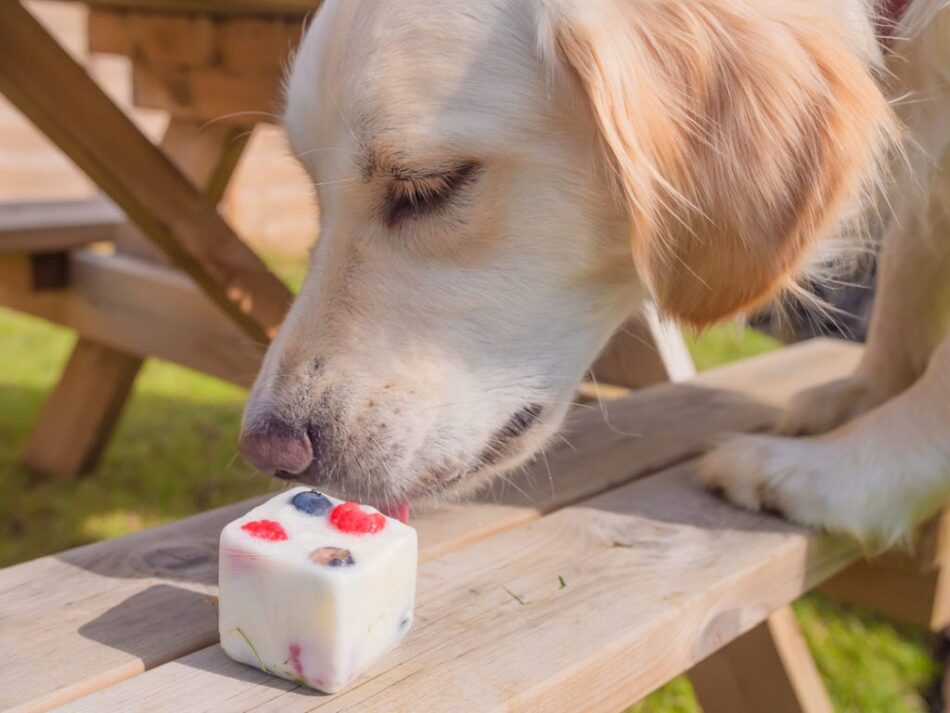
This entry was posted in Dogs
You’ve seen it on some TV programmes or driven past small-holdings and seen canines and chooks living in harmony. Maybe they are a working dog? Maybe they are a family dog? How do they do it? We have put together 7 expert tips to help you introduce your new dog to a flock of chickens.
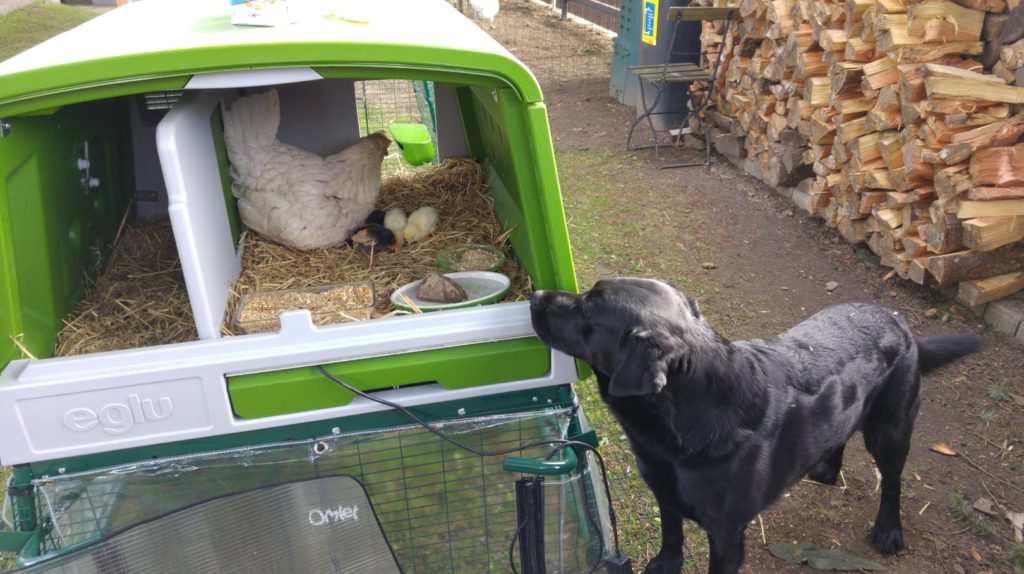
Understand How Dogs and Animals Learn
Our canine companions, on the whole, are super intelligent and trainable, providing we know how they learn and what we need to do to train them. Introducing them to our chooks can be done and co-habiting harmony does exist. It’s through this small thing we call desensitization. Stay with us for a short Psych 101 and we promise it’ll be worth it.
Desensitization is a process where, through graded exposure, an emotional response is diminished and adapted to a specific stimulus.
Now, what the heck does that mean I hear you yell?
In short, you expose your dog to your chooks, from a distance. As he behaves how you expect him to, you gradually move him closer to the chooks. You eventually get to the stage, that through the gradual exposure, he’s not that interested in the chooks after all. His emotional response has diminished, and he has adapted which results in a calm response.
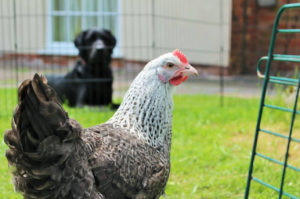
Stay Safe
Start with your chooks in their coop or a fenced in area. Keep your dog on leash and feed him treats, providing he is ignoring the chooks. If he is paying too much attention to them, move to a greater distance. The aim is to find a distance where he is not having any emotional response towards them.
Grade the Exposure
Providing your dog is ignoring the chooks at a certain distance, you can move gradually closer to them. Say you start at 50 feet away, slowly reduce to 45 feet, 40 feet and so on. Continue to praise and reward him for ignoring them. Remember, you want his emotional response to diminish. Keep training sessions short, you don’t want to over tire your dog. Some dogs get hyper-aroused just by being over-tired.
The Big Moment!
You’ve finally made it to near the chicken coop or fence, providing he is still pretty chilled out in ignorance of the chooks, ask him to sit next to the fence or coop. Praise and reward. If he behaves how you expect him to, lengthen the leash, so he can move around the border of the coop or fence, he can sniff and explore. If he’s calm, the chooks may even come over to investigate. Stay calm. If he starts getting excited or lunges/barks at them, remove him to a safe distance where he will ignore them again. You may need to do this a few times. What he learns is that to be around the chooks, I must stay calm. If your chooks will stay in a coop or fenced area, this may be where you spend the time repeating the behaviour and praising and rewarding. You may sit with him with a chew or just work on some commands. Again, the aim is to encourage him to ignore the chooks.
If you plan on having free range chickens, and canine and chooks will be mingling daily, read on.
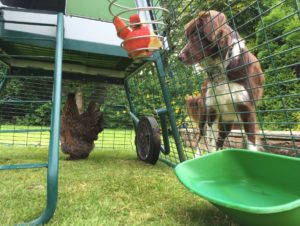 The Great Escape
The Great Escape
When you feel confident that your dog has so far, happily ignored the chooks and not shown any aggression or heightened arousal towards them, you can let them out of their coop/area to roam freely. Keep your dog on his leash. Ask him to sit or lay down if this makes you feel more comfortable. As the chooks are roaming, providing your dog shows little interest, praise and reward him. Again, you may want to give him a chew or even a slow feeding puzzle game. He just needs to learn than he can co-exist with the chickens without interacting with them a great deal.
Patience Is A Virtue
You may have to spend a significant amount of time working through these steps, but done in the right way, it will be worth it. Whilst on leash you can walk him through the chooks, he may sniff, they may also show interest too. The only behaviour you don’t want to see is aggression, lunging or chasing. If this happens, go straight back to beginning and work on the gradual exposure again.
Riding Solo?
The most nerve-wracking part will likely be when you feel he is ready to be let off leash to mingle on his own. Again, take your time. You may pop the chickens back in the coop and let him explore off leash around a fence. You may prefer to put him on a long line (50ft) when in with the free-range chooks. This way, he feels like he has more freedom, but you still have control if it goes pear shaped. Be realistic though, some dogs just never quite make it to being able to mingle unsupervised with chooks, so watch the behaviour of your dog and make the call.
Conclusion
Chooks to dogs are super-interesting, like most things. The long and the short of it, successful introductions mean the chooks are no longer that interesting and your dog learns that to be around them he simply just needs to be calm. Arm yourself with some high value treats, chews and any other slow feeder puzzles; start from a distance and encourage the behaviour you want to see. Praise and reward when you do. Grade the exposure. Always stay calm and in control and don’t be afraid of going back to square one if things don’t go as you’d hoped. It may take time, but it will be worth it when you have canine and chooks living in harmony.
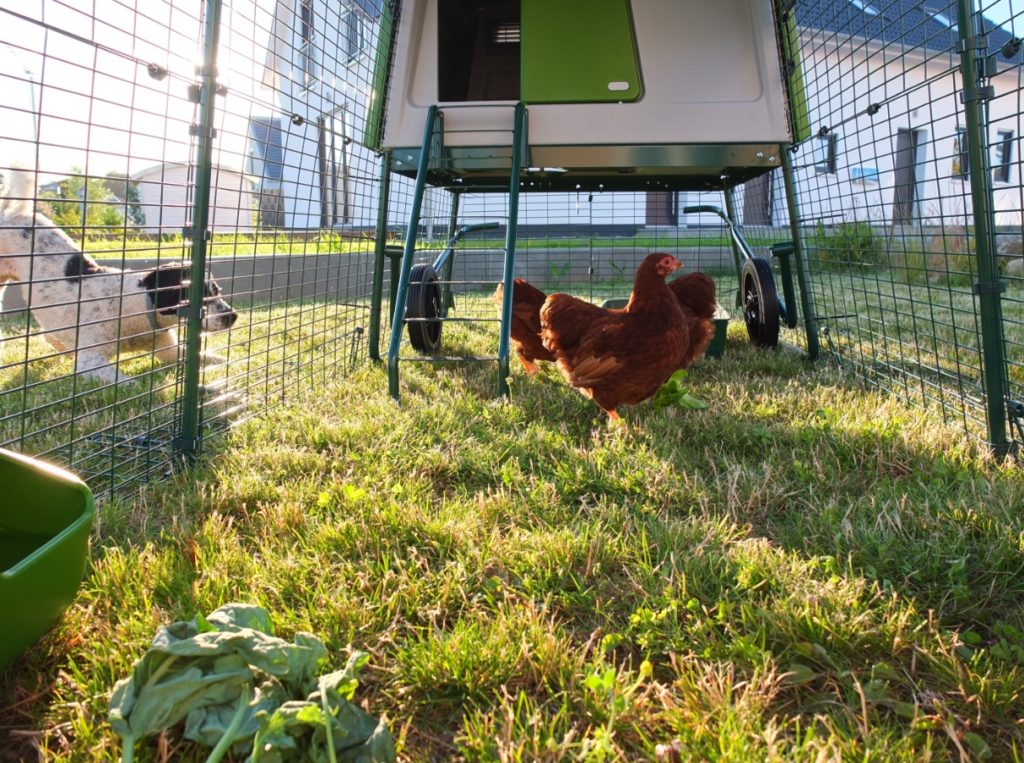
 This post was written by John Wood at All Things Dogs.
This post was written by John Wood at All Things Dogs.
This entry was posted in Chickens
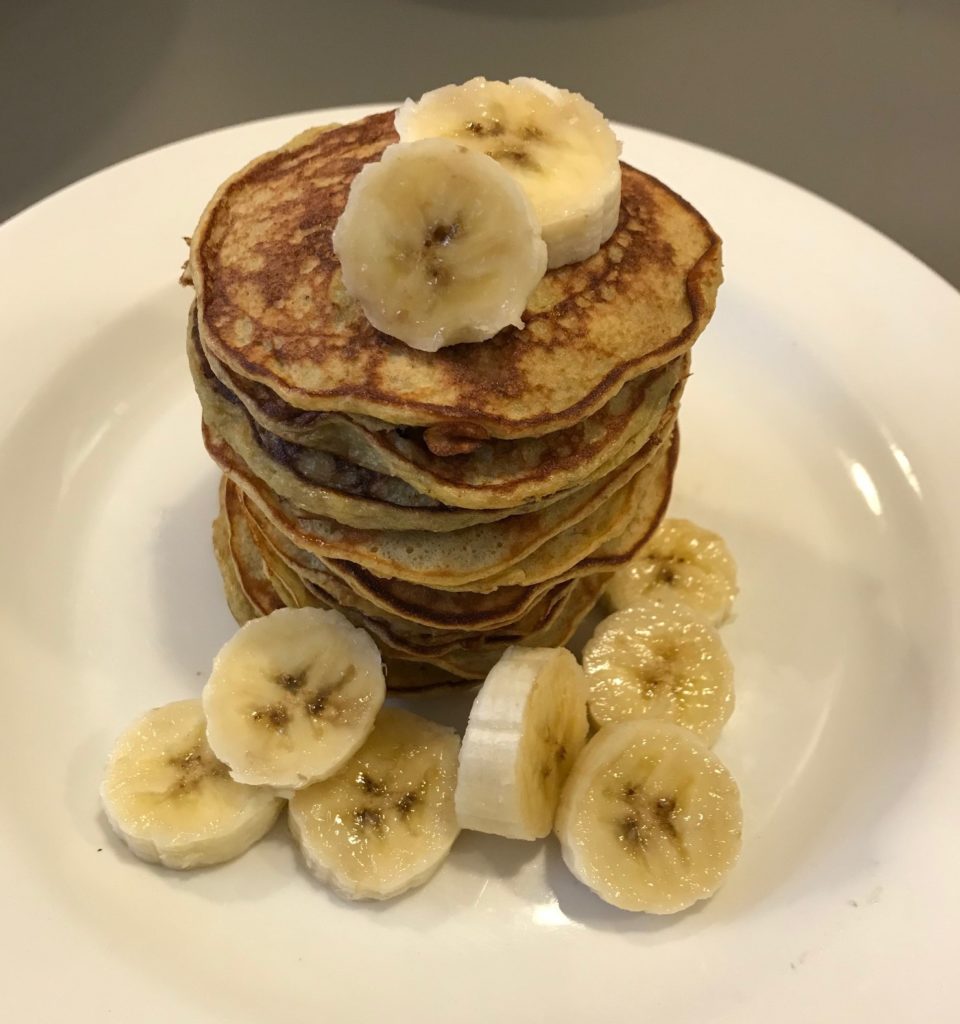
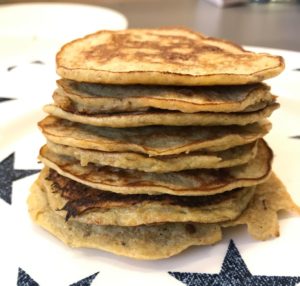
Try something new for your pup and treat them to this dog-friendly pancake recipe with all the trimmings. This is also a delicious, healthy option for humans, too!
All you need for the pancakes are –
- 2 eggs
- 2 ripe bananas
- 1 tablespoon of flour
- Coconut oil spray for frying pan
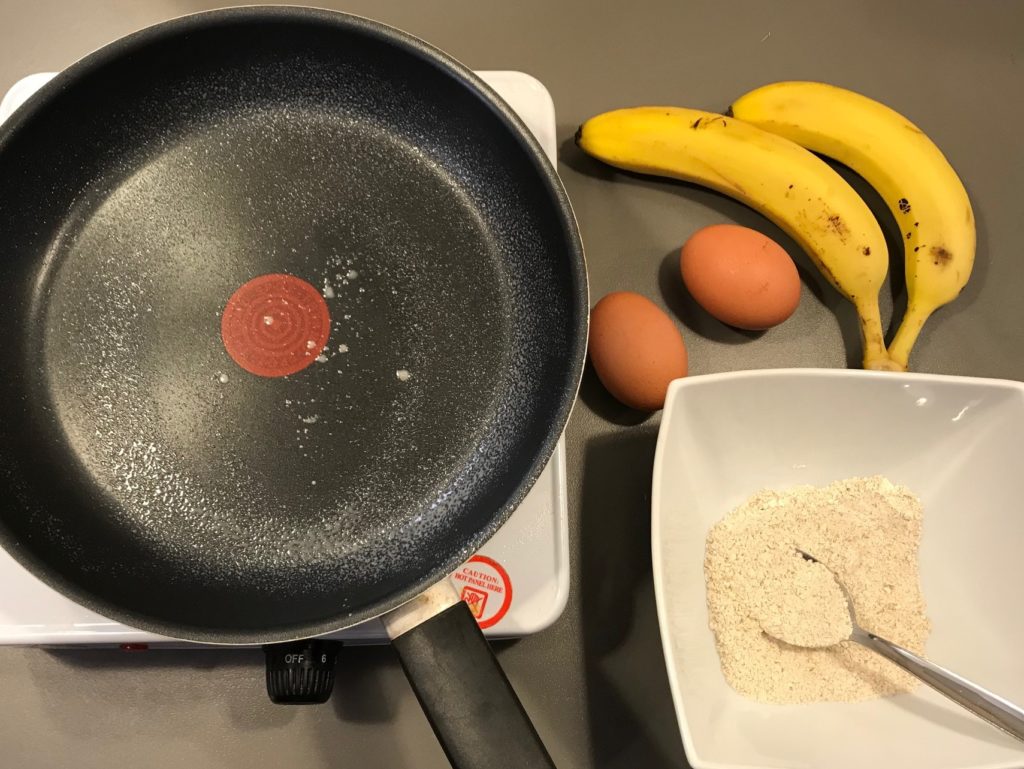
Eggs are a great source of protein for dogs, and are full of vitamins which can benefit their diet. Bananas are also rich in vitamins and minerals, and they also help boost your dog’s immune system and skin health.
Mash up the bananas in a bowl or food processor. Add the eggs and mix. Thicken with flour until the mixture forms a batter-like texture. Spray the frying pan with Coconut Oil Spray on a medium temperature. Add a tablespoon of the mix into the frying pan and cook for 2-3 minutes. Flip and cook the other side. Allow the pancakes to cool before giving to your dog.
Suggested toppings for your dog’s pancakes –
- More bananas!
- Greek yoghurt
- Peanut butter (check there is no xylitol in ingredients)
- Blueberries
- Strawberries
- Apple
- Cottage cheese
- Small cubes of cheddar cheese
- Their own treats!
Flipping fantastic! Join the fun on Instagram and tag us in videos of your dog attempting to catch their pancake using the hashtag #FlippingFido.
Remember dogs should only have treats in moderation so consider the portion which is appropriate for the size of your dog to avoid overfeeding.
This entry was posted in Dogs
In this post we’re introducing Esme, the latest addition to the Omlet HQ Pet family. This new puppy colleague has reminded us all of the crazy things we say to or about our dogs. Only truly mad dog parents will be guilty of saying these things…and also happily admit to it. If you think of someone while reading these, make sure you name and shame them on social media using #OmletPets.
“Can I work from home today?”
“Why?”
“My dog gets lonely…”

“Oh, don’t worry the dog will clean it up…”


“Go do wee-wees, go on”
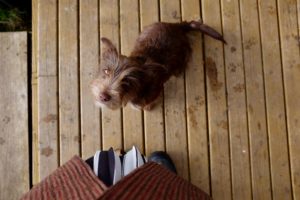
“Sorry I’m late, my dog was -”

“Oh my God, my dog did the cutest thing this morning…”

“Sorry, she’s a licker”
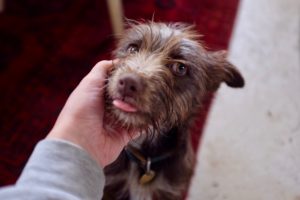
“LOOK AT YOUR LITTLE FACE!”

“OH I MISSED YOU TOO!”

“Who’sacutiewootiethenyesyou’reacutiewootieyesyouare”

“Hey, you free tonight?”
“No, I’m cuddling my dog.”

This entry was posted in Dogs
For Valentine’s Day we wanted to find out how much love you have for your four legged friends vs the affection you have for your partner? We surveyed over 400 dog owners. The results are in and they make an interesting, yet not surprising read!
Among the key findings includes:
78% expressed that their dog is more attentive than their partner!
75% said their dog brings out their best side more than their partner does!
Check out the infographic below to see all the results!
This entry was posted in Dogs
These delicious Apple and Cinnamon Dog Cookies are a great Christmas treat for your pooch this festive season, and they’re healthy!
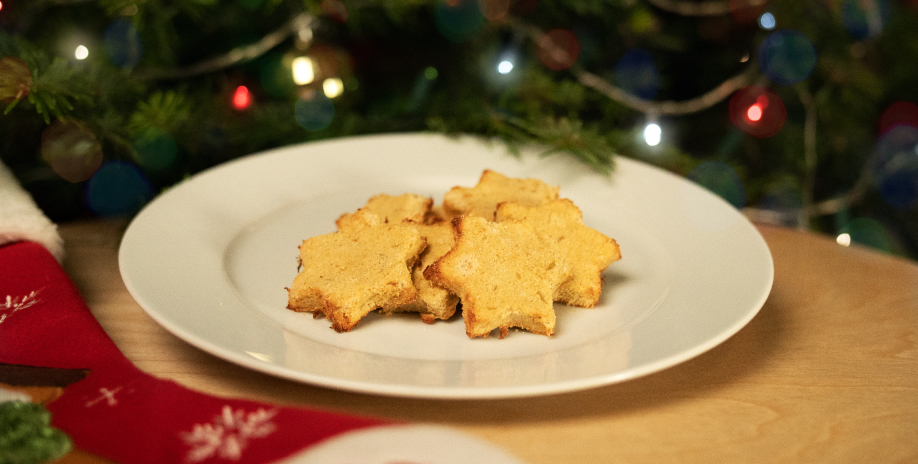
Ingredients
Makes 10 cookies
70g coconut flour
1 egg
3 teaspoons of coconut oil
Pinch of cinnamon
1 apple (grated)
And a cookie cutter
180 C for 15 minutes
(160 C fan assisted or gas mark 4)
- Preheat the oven to 160c and prepare a baking tray with baking paper.
- Heat 3 teaspoons of coconut oil in a bowl in the microwave for 1 minute, or until soft.
- Mix together the egg, coconut oil in a bowl.
- Grate 1 apple into the bowl and mix.
- Add a pinch of cinnamon to the mix.
- Weigh out 70g of coconut flour into a separate bowl, and start to add a bit of flour at a time to the wet mixture, stirring as you go.
- Continue adding coconut flour and mixing until you get a dough like consistency. You may not need to use all the flour to achieve this. The texture will be sticky and slightly crumbly.
- Dust some coconut flour onto a clean surface and place the dough on top.
- Flatten the dough with a rolling pin or your hands until it is approximately 1 cm thick
- Use a small cookie cutter (approx 5cm diameter) to press out shapes in the dough and place them onto the baking tray. Handle these carefully as the dough can be fragile due to the lack of fat in the recipe (too much fat is unhealthy for dogs!)
- Once all the dough has been used and the cookies are all placed on the baking tray, place them in the oven for approximately 15 minutes, keeping an eye that they do not burn.
- Take them out the oven and leave to cool, at this point they will firm up a bit more, so handle carefully.
- Once cool, store in a cool dry place, and treat your dog to a delicious cookie!
Health Benefits
- Coconut flour is gluten free, perfect for dogs who suffer an intolerance of wheat. It’s also low in sugar and high in protein, fibre, and healthy fats.
- In small quantities, coconut oil can promote a healthy coat, improve digestion and assist the immune system.
- Eggs are also great for extra protein in your dog’s diet
- Did you know, cinnamon can be incredibly helpful for senior dogs who are suffering with arthritis? Adding a small amount to your dog’s diet can be incredibly beneficial.
- Apples are a source of Vitamin A and C so make a great, healthy treat for your dog, but don’t feed them the core when you have finished grating the apple, as the seeds are harmful.
As always, treats should be given to dogs alongside a healthy balanced diet, and do not feed them too many at a time.
We’d love to see your photos of this cookie recipe, tag us on Instagram using #OmletPets.
Sources:
https://www.chewchewtreats.ca/blogs/chewchew-treats-blog/coconut-flour-benefits-for-dogs
https://www.cesarsway.com/dog-care/nutrition/dog-approved-people-food
https://www.dogster.com/dog-food/about-cinnamon-for-dogs
https://moderndogmagazine.com/articles/can-dogs-eat-apples/29085
https://www.dogsnaturallymagazine.com/the-health-benefits-of-coconut-oil/
This entry was posted in Dogs
In August the Danish Bulldog Club hosted a bulldog show in Denmark, where Omlet sponsored prizes for the ‘Most Beautiful Head’ category! We had a chat with the organisers to learn a bit more about the bulldog and find out why they focus so much on promoting the healthy bulldog.
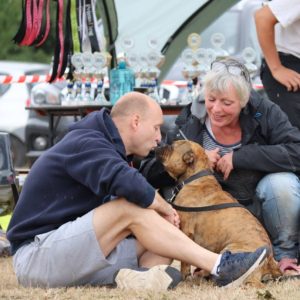
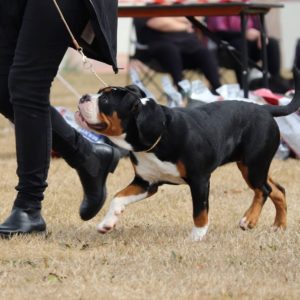
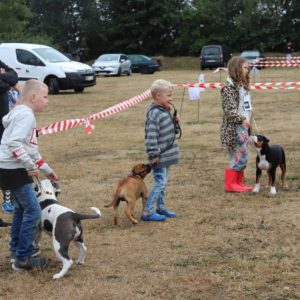
Why is there a focus on promoting health in bulldogs at this show?
We focus on promoting bulldog health at all our shows and the reason why we have so much focus precisely on health is that many bulldogs (many different varieties) unfortunately have become more and more at risk of illness.
We believe it’s important to show the healthy dog that can breathe, move freely, is not bothered by allergies etc.
What are the signs of a healthy bulldog? And what are the most common health problems in bulldogs?
A healthy bulldog can move around freely. Meaning it is not physically limited. Open nostrils that do not create breathing problems, and it’s important that they are not overweight since this can put pressure on their hips etc.
The most common health problems are skin problems, hip/elbow dysplasia, breathing problems/narrow nostrils.


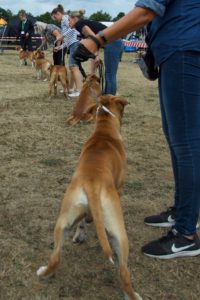

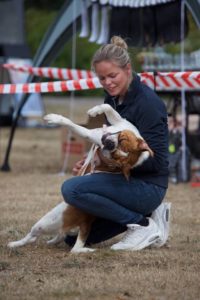
For those interested in getting a bulldog, what can they do to ensure they buy a healthy one? And how can you help your bulldog stay healthy if you already have one?
When buying a bulldog, the best way you can make sure it’s healthy is by seeing documentation for the parents such as x-rays of the hips, elbows, back etc. If possible, it is best to met both parents, but at least you need to see the mother.
Likewise, it’s important that you familiarise yourself with the breed and for instance go to a show where you can see and meet different dogs and breeders.
When you have your bulldog, the best thing you can do is to keep it slender/muscular and in good shape. Make sure it gets the right amount of exercise, food and lots of love. Remember that the bulldog is not just a sofadog. A bulldog needs exercise and stimulation just like other breeds.
What is the best thing about bulldogs compared to other dog breeds?
The bulldog is a very versatile breed which is suitable for everything from family dog to a hardworking training buddy.
The dogs enormous personality makes it a fun and loving member of the family and its muscular body og strong determination makes it the ultimate training partner for everything from obedience to weightpull.
Generally, the bulldog easily adapts to the individual family’s needs.
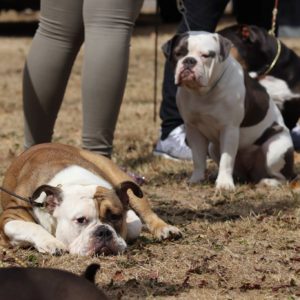
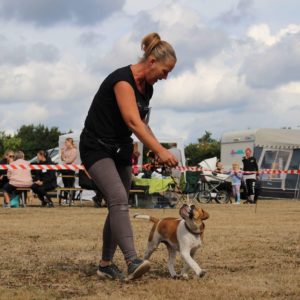
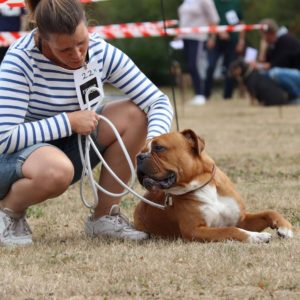
How many different varieties of bulldog are there and do you host shows for all of them in DBC?
There are: English Bulldog, French Bulldog, Old English Bulldog, Leavitt Bulldog, Renascence Bulldog, Continental Bulldog, American Bulldog etc.
However, in Denmark the American Bulldog is illegal.
So far, we only host shows for the OEB and Leavitt Bulldogs.
What might people not know about bulldogs?
They are super charming and very stubborn but they bring out smiles and laughs every single day.
***Winners of the ‘Most Beautiful Head’ category – sponsored by Omlet***
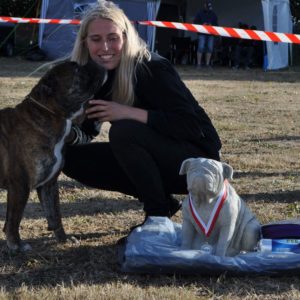
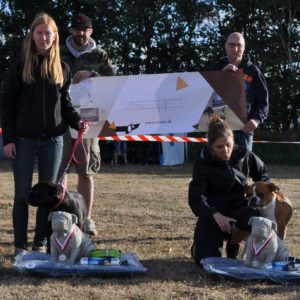
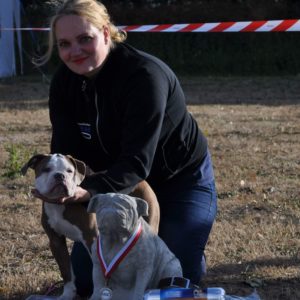
This entry was posted in Dogs
We all have our bolt holes – that little space in the home with our personal stamp on it. It might be a bedroom, a hot bath, a study, a garden shed, or just a comfy chair. The important thing is that it comes with an unwritten message: Do Not Disturb.
Dogs are no different. When the stress levels rise, or when the busy day demands some down time, they need a den, a cosy corner that they can call their own.
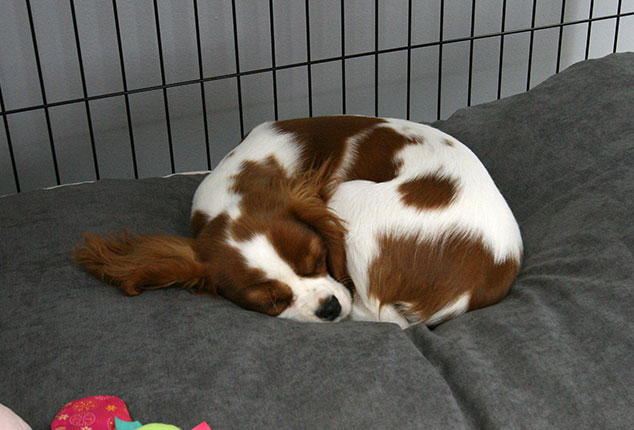
Why the Crate is Great
Many dog owners don’t consider buying a crate. This is a missed opportunity, as crate training sets up a young dog for life. It gives your pet an appropriate sense of territory and personal space, and speeds up toilet training.
A crate also acts as a cosy corner and personal space. It’s important to realise how easily a dog can become uncomfortable in the home. Some are more panicky than others, but all dogs will experience some level of anxiety when unexpected things happen.
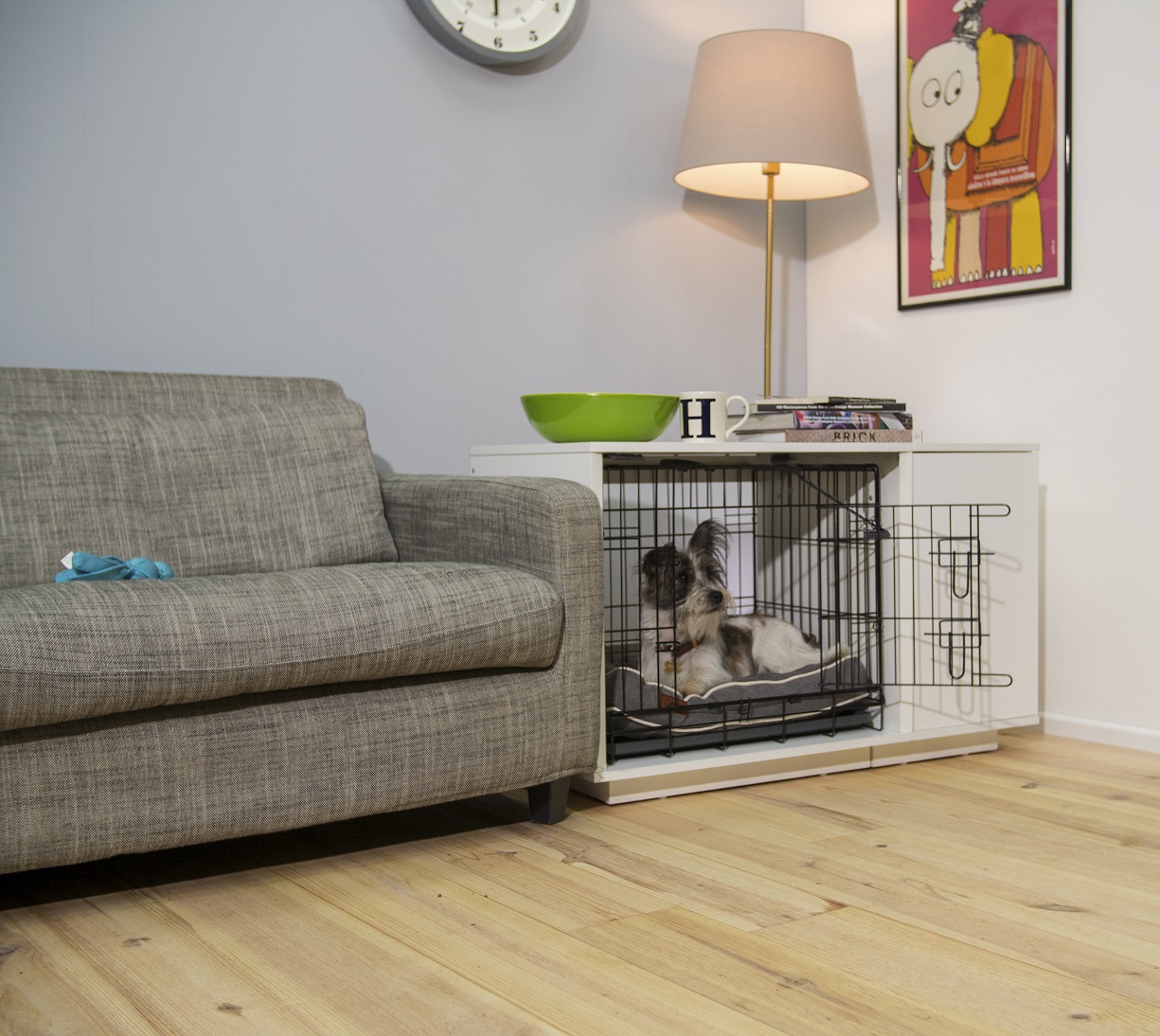
This can include loud noises, changes in routine or the sudden arrival of strangers. The brains of dogs and humans alike react to undesirable situations by flooding the body with the “fight or flight” stress hormone cortisol. A constant flood of cortisol has a negative effect on an animal’s health; while opting for “fight” rather than “flight” has obvious hazards all dog owners want to avoid.
A crate provides the “flight” option – somewhere to run to and escape the source of anxiety.
How to Spot the Signs of Stress
Humans communicate stress easily. Dogs do the same, but mainly through body language. Here’s what to look out for:
- The stress yawn – sometimes accompanied with a whine
- Panting for no obvious reason
- Growling
- “Cringing”, with tail low or tucked between the legs
- Stiff body posture
- Ears pulled and held flat against the head
- Turning away and avoiding eye contact.
Part of the Furniture
The crate alone won’t stop your dog woofing at loud noises and growling at strangers. He will need training sessions too. Without these, he might simply run to the bolt hole and continue to bark.
Combined with training and desensitising, though, a crate can be a real life saver. But that doesn’t alter the fact that a great big cage plonked in the living room isn’t necessarily going to blend in with the rest of your décor.
It was this tension between the necessity of a crate and its intrinsic ugliness that inspired us to design the Fido Nook. It’s a piece of stylish furniture, complete with a wardrobe section for doggy bits and pieces, into which a crate can be placed. With the crate removed, the Fido Nook is still a lovely piece of furniture, and, more importantly, provides a comfy kennel space – your dog’s own special home within the home.
The Fido Nook will de-stress your dog in style. Bolt holes have never looked so good!
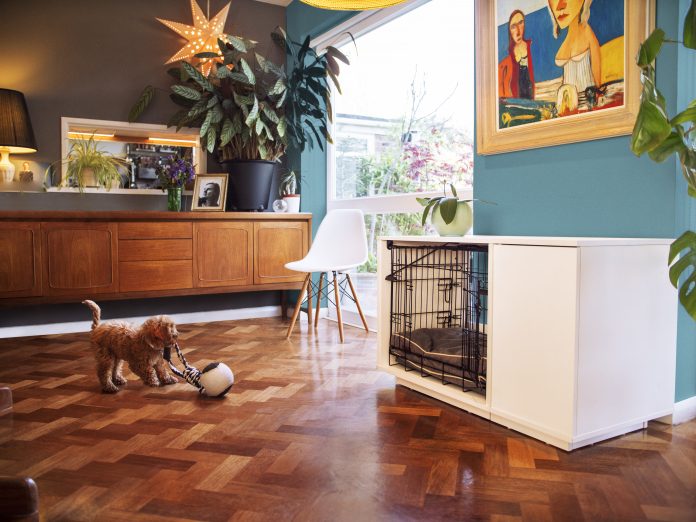
This entry was posted in Dogs
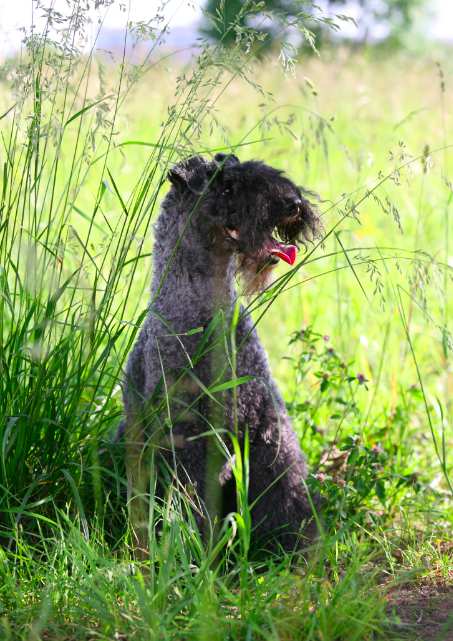
Hay fever is a type of inflammation which occurs when the immune system overreacts to allergens in the air. Hay fever (or Allergic rhinitis) is typically triggered by environmental allergens such as pollen, pet hair, dust or mold. The condition can make feel people who are prone to it feel really miserable. But did you know dogs (and cats) can suffer from hay fever too? However, their immune systems are not the same as ours, so sneezing and runny noses aren’t usually the presenting symptoms. Pets with hay fever are often very itchy all over their bodies. The most commonly affected areas of the skin include the armpits, the groin, the base of the tail, the feet and the sides of the face. Signs of canine hay fever involve:
• Itching and scratching
• Bold spots
• Rash on the face and paws
• Redness
• Ear infections
• Scabs and lumps in the skin
Hay fever is a seasonal allergy, so the greatest problems will be during the summer and early fall. Some dog breeds seem to be particularly prone to hay fever, including terriers, poodles, schnauzers and the Dalmatian. Like humans, dogs can develop hay fever at any age although symptoms often begin when dogs are 1 to 3 years old. It can be difficult to figure out what’s causing your dog’s allergies, since the symptoms of hay fever are similar to many other things. Your vet can do allergy testing to identify if hay fever is indeed causing the problem.
CAN CANINE HAY FEVER BE TREATED?
With hay fever it’s not possible to remove the source of the allergy and unfortunately there is no cure for it. But there are a few things you can do for your dog to make him feel better:
• Keep your dog indoors as much as possible on days when pollen counts are high, especially on windy days.
• Wash your dog’s bedding weekly with hot water and vacuum regularly to remove the pollen your dog picked up during walks.
• Choose the areas where you walk your dog carefully, keeping him away from longer grass and vegetation.
• Wipe your dog’s coat over with a damp towel immediately after a walk to remove any pollen. Start with the face and end with the legs and paws (your dog may have been running on grass, coming into direct contact with pollen).
• Boost your dog’s immune system. By improving the general health of your dog allergic reactions can be helped. Make sure your dog has a healthy weight and a balanced diet.
• Give your dog oatmeal baths frequently to sooth the skin and remove pollen. Oatmeal can give your dog temporarily relief from dry and itchy skin. Just poor one cup crushed whole oatmeal in a tub and stir. You can also use an oatmeal shampoo for dogs or other shampoo’s designed to reduce skin problems (although not so frequently that it dries out the skin).
• For the rare cases where pollen allergy does provoke sneezing and runny eyes, eye and nose drops supplied by the vet can be effective.
If none of the mentioned treatments prove effective, your dog might be a candidate for hay fever medication or allergy shots. Consult your vet for further information.

sources: www.vetinfo.com, www.pets4homes.co.uk, www.kingsteigntonvetgroup.co.uk, www.selfselectionforanimals.co.uk
This entry was posted in Dogs
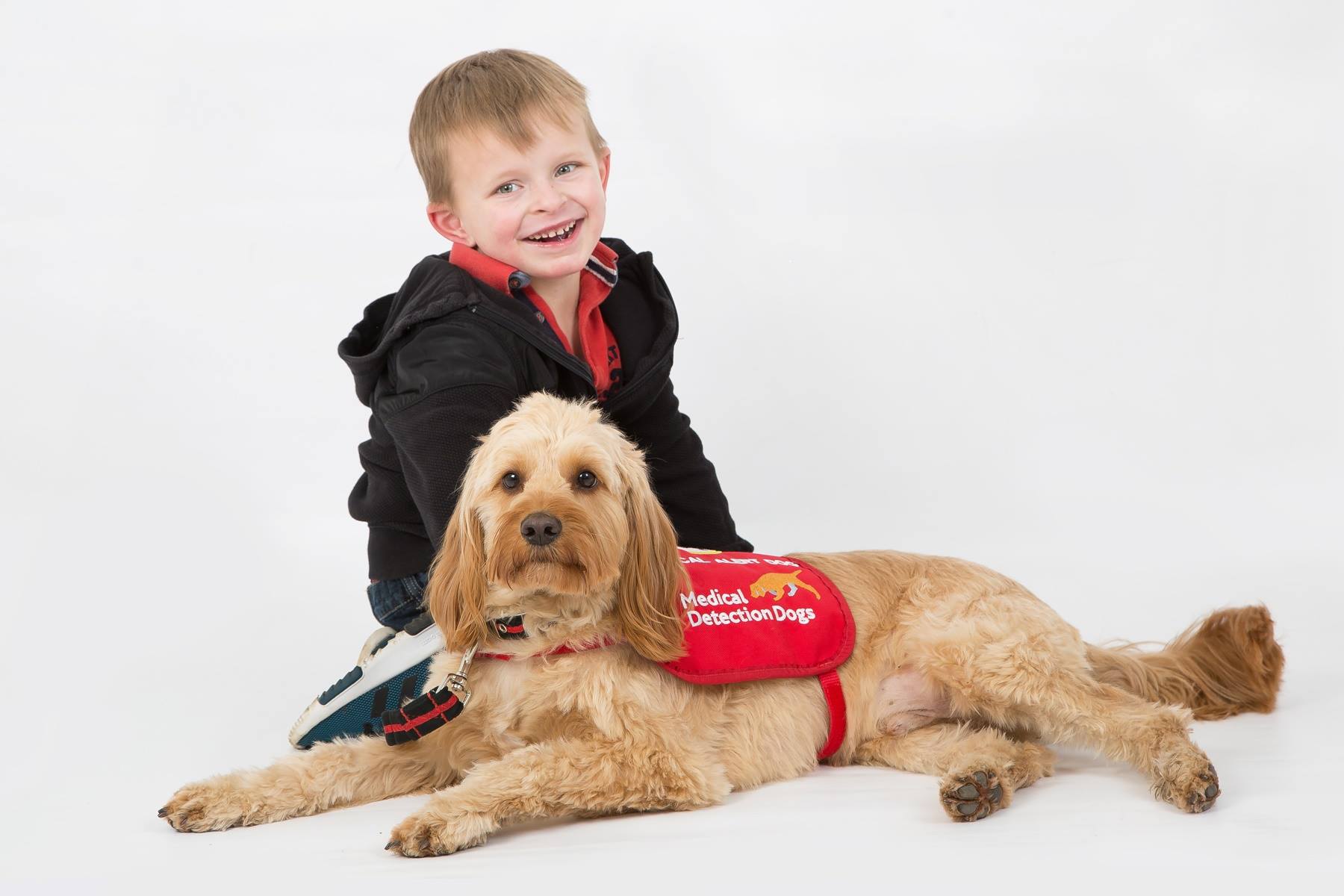
Rocky is a Medical Alert Assistance Dog and a fantastic companion for 7 year old Josh who has unexplained hypoglycemia and Epilepsy and has had many hospital stays since he was born. Rocky has been trained by the Medical Detection Dogs charity to alert Josh’s family when his blood sugars drop dangerously low and could trigger a seizure.
We spoke to Josh’s mum Paula to find our more about this delightful friendship!
What type of dog is Rocky? He’s a Cockapoo
How old is he? He’ll be 2 on the 28th September. He joined our family when he was 9 weeks old.
What does Rocky do to help Josh on a daily basis?
Rocky spends all his time with Josh and alerts us when his blood sugars drop too low by sense of smell. Josh has unexplained hypoglycemia along with epilepsy and his seizures can be triggered by low blood sugar. We test Josh’s blood sugar numerous times a day but are extremely lucky to have Rocky with us who has alerted us many times when his blood sugars drop to a dangerous level which has fortunately stopped things escalating to a medical emergency. Rocky sleeps in Josh’s room and we are confident he will come and wake us if he ever senses a problem.
If Rocky wants to alert Josh, he stands on his back legs and puts his paws on Josh’s shoulder and licks his face. If Josh is asleep he comes to find me and licks my hands to wake me.
Did the Medical Detection Dog Charity advise you about what type of dog to get? We had spoken with the charity prior to buying Rocky and knew what to look for when looking for a puppy to give us the best possible chance of buying a puppy that we may be able to train successfully. Obviously we knew there were no guarantees on this and also looked for a puppy we thought would be the ‘best fit’ as our new family member.
Did you have to crate train him or was he already crate trained when you got him? We chose to crate train. He was used to a crate from being with Mum so it was very straight forward. He took his blanket in with him and was always happy. The training we did with Rocky with the crate was very easy, primarily due to him already being used to one.
During Rocky’s Medical Detection Dog training did you have to attend lots of classes? Rocky and I used to have one to one training on a weekly basis. Josh attended the training whenever possible. I would also send off any records of alerting behaviours along with all of Josh’s blood sugar recordings.
What did the training include? Where was the training held? The training was held at a variety of places. It included public access, off lead walking, heal work, distraction work etc etc. We had a train trip, a bus trip, taxi ride, public access – so inside shops, supermarkets etc, in school, busy places and quieter places, all to see how Rocky would react. And of course, a vet visit.
How long did the training take from start to finish? Rocky qualified at 18 months of age. The youngest possible age to qualify. We were training with him from the moment he came home at 9 weeks of age.
Do you have to go for additional training even now he has qualified? We have a first post qualification check 6 months from qualification and then every 12 months after. If we come across any problems at all at any point, we are fully encouraged to speak with MDD for full support wherever it is needed. We will also attend regular refresher training to ensure Rocky maintains his high standard of behaviour and alerting.
What type of treats do you feed Rocky as a reward? Rocky always has the same reward, dehydrated hotdog sausage – his absolute favourite!
Is Rocky allowed to go everywhere with Josh?
Yes he is. Rocky has to wear his ‘Medical Alert Assistance Dog’ tabbard whenever we are out in public and is allowed in all public access areas including shops, restaurants, beaches and cinemas.
Rocky and Josh are best friends. Josh trusts Rocky completely and understands that he helps to keep him safe. Rocky is simply a life changing member of our family.
—————————–
Medical Detection Dogs is a fabulous charity that trains dogs to detect the odour of human disease. It is at the forefront of the research into the fight against cancer and helping people with life-threatening diseases. To find out more about the amazing work that they do click here
If you are looking to crate train your dog, click here to find out more about the Fido Studio Dog Crate
This entry was posted in Dogs
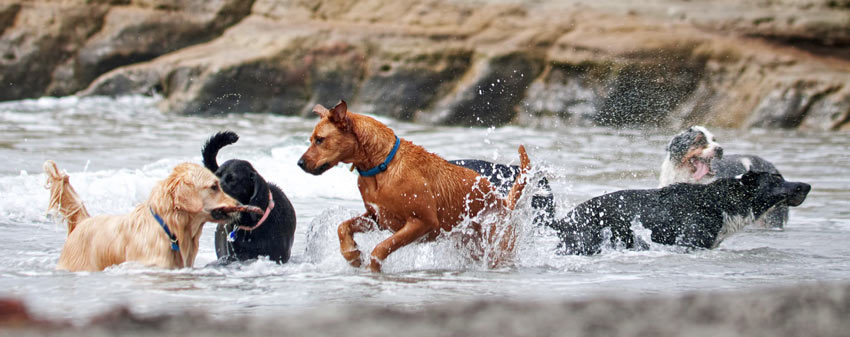
Many of us would agree that there are few things nicer on a hot summer’s day than a trip to the beach, and as long as you come prepared there is no reason to leave your pooch at home. Swimming is one of the best forms of exercise for dogs, and you can stay as long as you like without having to worry about getting home to let the dog out!
There are however a few things you need to do before you leave, and some things that are good to know when it comes to dogs and the beach. Here are our best tips for a successful outing!
Find a dog-friendly beach
Dogs are not always allowed on public beaches, but there is normally an area close-by where you can take your dog. Search for a dog-friendly beach nearby, read up on the rules, and make sure you follow them!
Keep an eye on your dog

Even if you’re at a dog-friendly beach you must always keep an eye on your dog, and show consideration to the other beach goers and dog owners. No one appreciates being sprayed with water from a wet dog as they’re relaxing with a good book! If you’re not absolutely sure your dog will come when you call or stay close to you, it might be best to keep it on the lead.
You also have to make sure your dog stays safe at the beach. Dogs are amazing at finding things in the sand that might not be good for them, everything from leftover barbecue ingredients to rotting fish. Glass, sharp shells, or even old fish hooks may hide in the sand, and can hurt your dog’s precious paws.
Teach your dog to swim
Many believe that all dogs know how to swim, but that is not the case. Even if all dogs will automatically paddle their feet if you put them in the water, there are several dog breeds that aren’t built to stay floating. Breeds with large heads and short legs will struggle to keep their head over the surface to breathe. If your dog seems to love swimming but you’re not completely sure about their ability, it might be a good idea to invest in a doggy life jacket.
That being said, there are lots of dogs that don’t really enjoy the water, or who will be perfectly happy running around in the shallow parts where they don’t have to swim. Never force a dog to come swimming with you!
Even if your dog is a strong swimmer, it’s important for you as an owner to keep an eye on them as they’re out in the water. Make sure you stay informed about currents in the water, and don’t let the dog in if there are high waves or lots of boats or jet skis around. Dogs can easily get too excited in the water and swim out into deep waters, where the current might be much stronger. You also have to supervise dogs playing and swimming with children.
Come prepared

Make sure you pack everything you need for a day at the beach. Dogs will need plenty of fresh water, so get enough for the whole family. It’s a good idea to have a collapsible water bowl, so you don’t have to make your dog drink straight from the bottle. This way you can also keep track of how much water the dog has actually had.
Bring toys that will entertain your dog throughout the day. If you’re able to throw balls or other toys down the beach, that is a perfect activity that will entertain your dogs, and give it a good amount of exercise. Just make sure the toys float if they end up in the water.
If you’re staying at the beach for a few hours, or maybe even the whole day, it’s important to make sure the dog can get some shade. If you’re not sure whether there are shaded areas where you’re going or not, bring a parasol or a small beach tent where the dog can relax during the hottest hours of the day.
Before you leave
Make sure you leave nothing behind, and clean up after yourself and your dog!
If there are taps or beach showers where you are, you might want to rinse your dog before you leave for the day. Salt can cause irritation to the dog’s skin, and sand can get in their eyes as they’re trying to get rid of it from their faces, which can cause eye infections and lots of discomfort. The dog will probably also have been exposed to plenty of dirt and bacteria during all the exploring.
If you can’t find any fresh water at the beach, it might be a good idea to scrub your dog with a towel before you get in the car (maybe mainly to not end up with a desert in the boot), and then give him or her a quick bath when you get home.

This entry was posted in Dogs
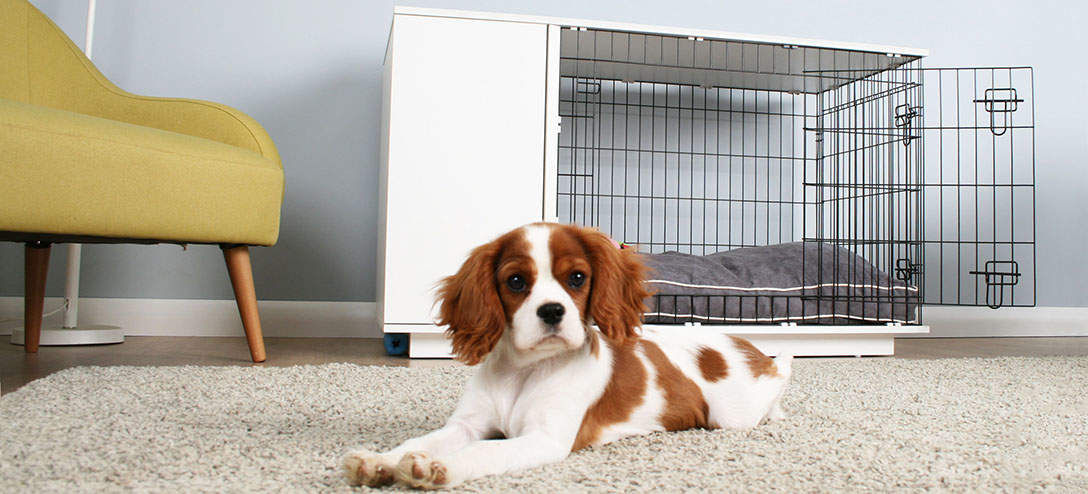
Why Crate Train?
It’s very common for people to assume that crate training is cruel and that dogs don’t like small spaces, but it has been shown that dogs love a calm, safe place that they can rest in and call their own. A dog crate offers a place to train as well as a place to sleep at night. It offers security from loud noises like fireworks and thunder, and a place to snooze after a long and tiring walk.
Crate training is an important process in your dog’s life, and is really helpful with toilet training your dog, so you’ll want to make the experience enjoyable for both you and your pet. The key thing is to make sure that your friend is happy and comfortable in their crate. There are a number of things that you can do to reinforce the idea that this is a nice, safe space for your dog to be in.
Here’s 7 reasons why crate training is important for a new puppy:
Security:
Appeals to a dog’s instinctual desire for a den-like structure.
Self-confidence
Sets a puppy up for success by reducing wee and poop accidents.
Self-reliance
Prepares a pup for handling alone time.
Privacy
Serves as a time-out device for pups and owners needing breaks.
Behavioural Health
Discourages and reduces separation anxiety in many cases.
Practicality
Gets pups used to confinement that may be required at the vet’s, the groomer’s and during car trips.
Transport Device
Contains a pup if he is injured and his mobility must be limited.
Make crate training an enjoyable experience
- Create a positive association with the crate using food and treats. Start feeding your dog near to the crate, and perhaps even put treats in the bedding. This way the idea of food, which is positive, will be associated with the crate.
- Use a blanket. Covering the top of the cage will give it a more solid, den-like appearance, and may make some dogs more comfortable with using it.
- Crate train slowly. You need to be patient with your pet, as this can be a bit of a difficult concept for them to grasp. If you rush training, it’s unlikely to stick, and this can create frustration for the pair of you.
The Fido Studio is perfect when crate training and it so much more than just an indoor dog crate. It’s the perfect compliment to your home and fulfills your dog’s natural instinct to have a den that they can call their own.
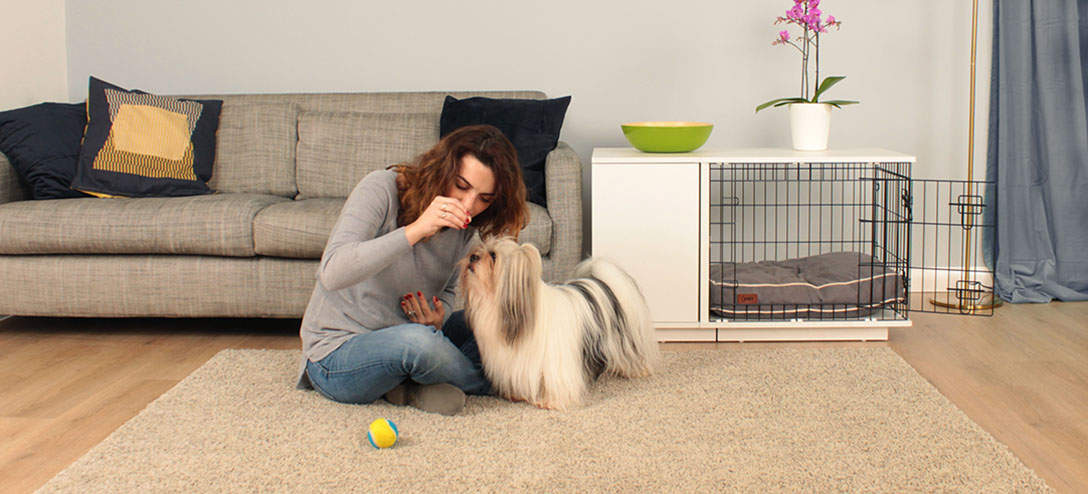
This entry was posted in Dogs
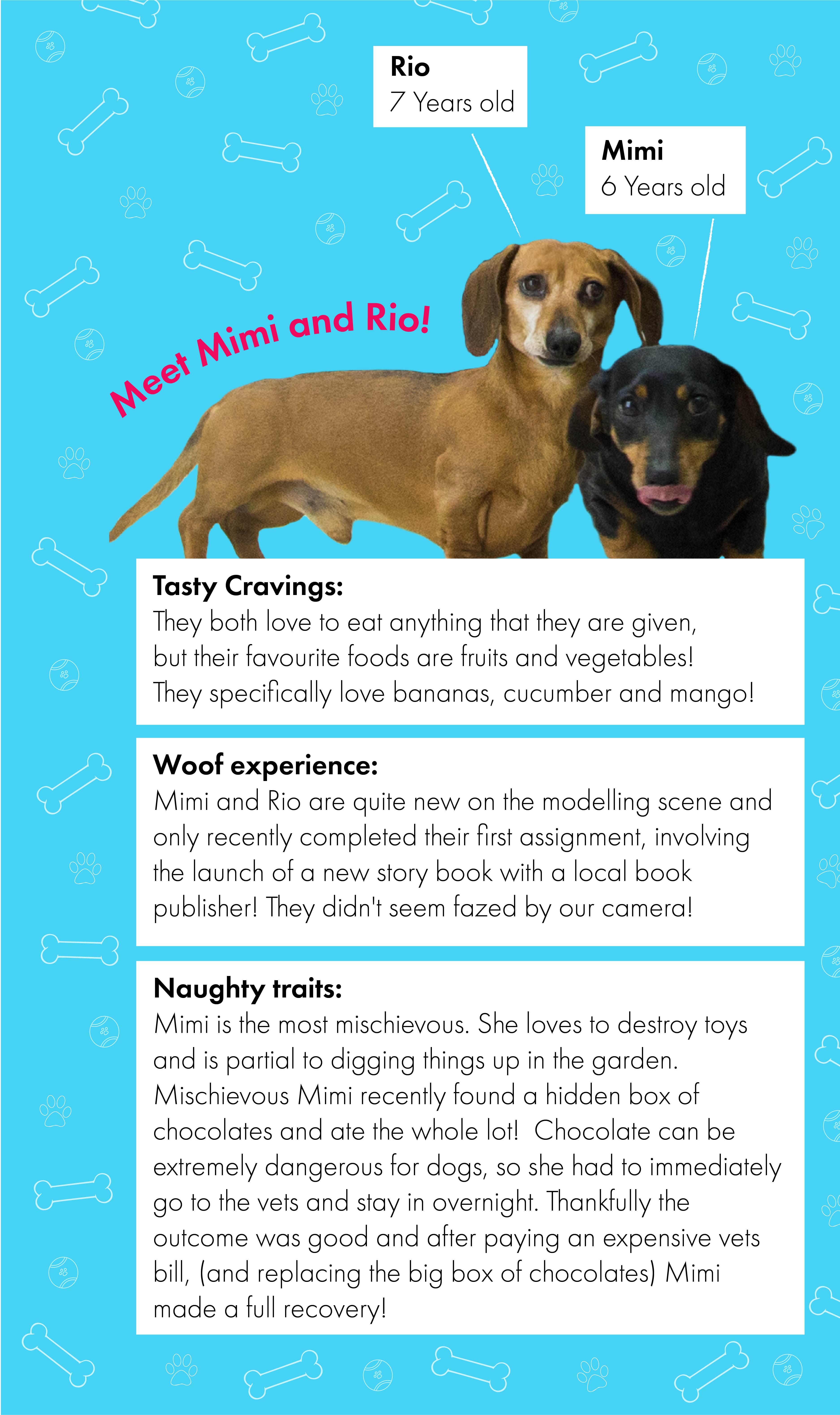
This entry was posted in Dogs
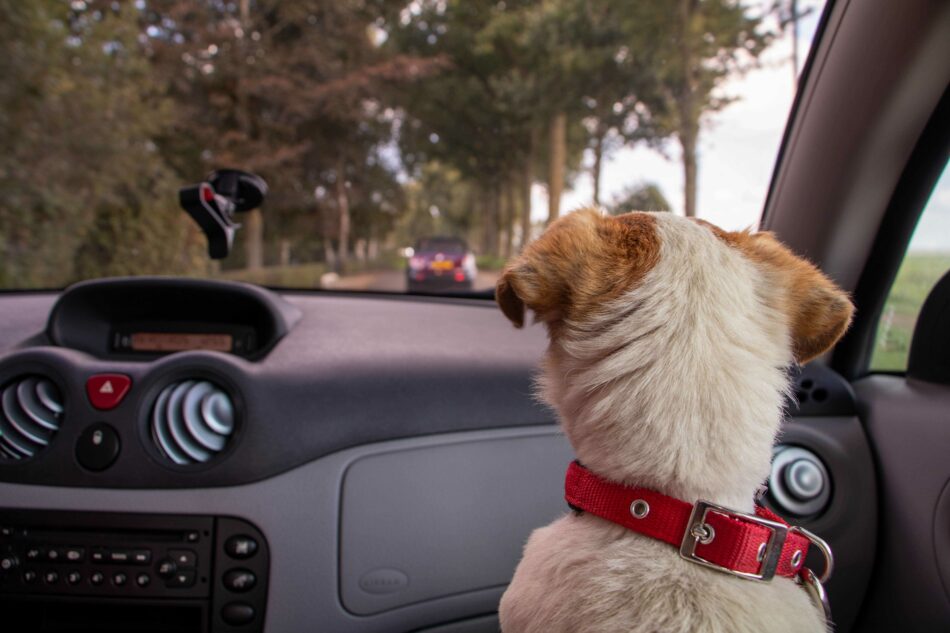
Heading out on a road trip with your dog? It’s great fun having a four-legged companion by your side for a long drive. Barking and singing along to your favourite playlist with the summer breeze blowing in your hair sounds blissful but, before you start your engine, buckle up for our doggy road trips dos and dont’s.
Safety first
Preparation is key to making sure your dog’s safety stays the number one priority on your adventure. In Australia, dog microchipping laws are defined by each state, but it’s highly recommended for the safety of your pet. Once this is ensured, you should also check your pup is up to date with their vaccinations and in good health before heading out.
If you’re planning on a long road trip, slowly ease your dog into spending more time travelling in the car. Just like us, some dogs suffer from motion sickness when in the car, so it’s important to assess how they cope on shorter trips first. If car sickness is something that they experience, contact your vet to see if they can prescribe medication.
Seatbelts on?
So, you’ve taken your dog to the vet and know they’re a good traveller – now what? It’s time to consider how you plan on restraining your dog on the journey. Using a dog seatbelt, dog crate or a dog guard are 3 ways you can keep Fido secure whilst in the car. And, depending on what state you live in, using a dog restraint whilst travelling is mandated by law.
If a crate is your dog’s desired method of transport, the Fido Classic is the ideal choice. Available in 3 sizes, the crate can fit dog breeds as small as a Yorkshire Terrier to those as large as 70 lbs. The crate can easily be folded too, making it perfect for packing away once you reach your destination.
Crate training your dog is an invaluable tool and will make travelling a lot easier for both you and your furry friend. Rather than seeing it as somewhere restrictive, a crate is a safe space for your dog to retreat to, anywhere they go. It will also make the journey and trip away a lot less stressful for everyone involved. Follow our dog crate training guide and see how simple it is for your dog to settle when they’re away from home.
Reminders of home
Road-tripping is great, but pangs of homesickness can set in at some point. Dogs can experience this too, so it’s a good idea to pack a few of their favourite things to remind them of home. Dog toys are essential for going away with your pup, just as they are back at home. Keeping your dog stimulated is super important once you arrive at your destination, so take along a long-lasting toy such as a Kong that will keep them entertained for hours, even in a new environment. Or how about taking along their cosy dog blanket or super soft dog bed for them to rest on when you stop?
Pit-stops pending
Your and your dog’s bags are packed and you’re ready to go! But just before you hit the road, make note of any breaks you’ll need to take. It goes without saying you should never leave a dog alone in the car. Regardless of the time of year, the temperature your car can reach unattended can be fatal for dogs, albeit dangerously hot or too cold. Cracking open a window is not enough to keep your dog safe from the elements when trapped in a car, so you’ll need to choose suitable pit-stop locations that are dog friendly. A quick search will bring up a number of locations where your pup will be able to stretch their legs, use the toilet and have a drink. Whilst your dog might not need to go potty as frequently, depending on their age, it’s wise to stop off somewhere every couple of hours for a break.
Omlet and your dog’s adventure
Whether you’re heading out on a big adventure or staying at home, Omlet has the products your dog needs to continue thriving. From ultra-soft dog beds to easy-to-travel dog crates and cosy dog blankets, we expertly engineer everything you need as a pet parent to ensure your four-legged friend lives their life to the fullest.
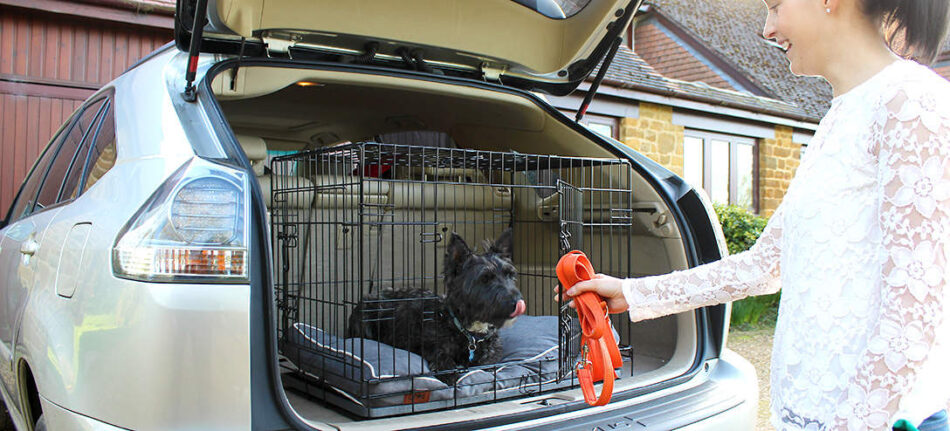
This entry was posted in Dogs
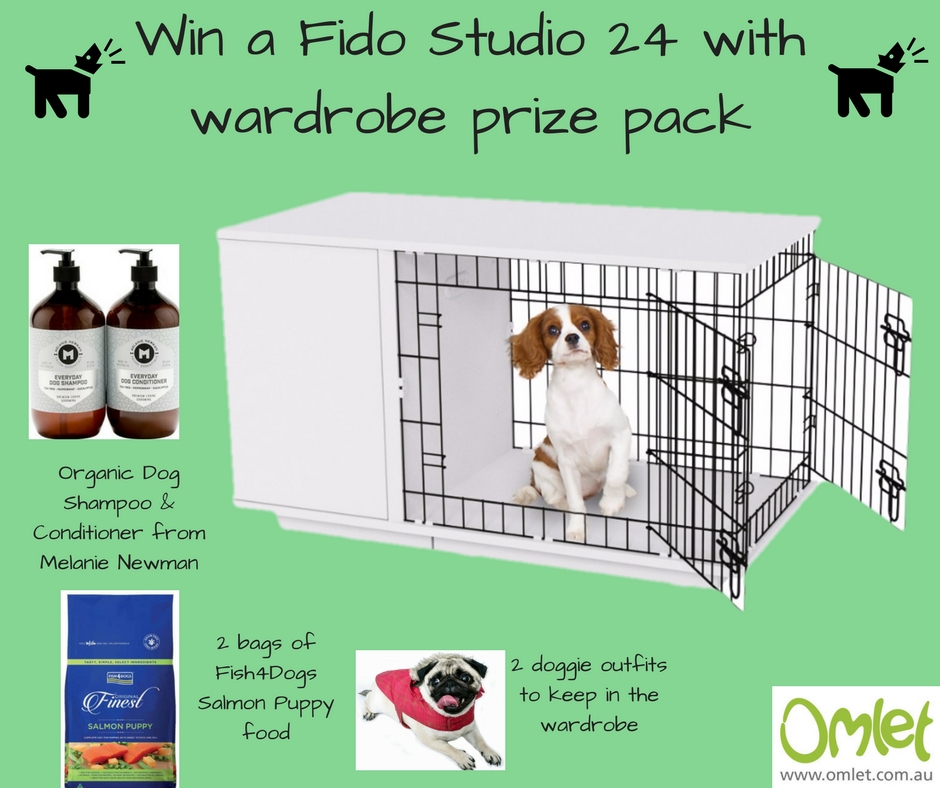
To celebrate the arrival of the new Fido Studio dog crate we have a competition to win a pawsome prize pack worth over $400!!!
The prize pack contains:
The new Fido Studio 24 dog crate with wardrobe and bed, as shown. The Fido Studio dog crate is designed like a piece of contemporary furniture, it is more than just an indoor dog crate. It’s the perfect compliment to your home and fulfills your dog’s natural instinct to have a den that they can call their own. The Fido Studio also brilliantly solves the issue of where to store all of your dog’s accessories. The wardrobe is a versatile and incredibly practical solution for storing your dog’s coat, treats, favourite toy and lead all in one handy place.
Dog shampoo and conditioner by Melanie Newman Salon Essentials. All the shampoo and conditioners by Melanie Newman Salon Essentials are pH balanced, pet friendly, no SLS or parabens, no petro-chemicals and no synthetic perfumes. 100% pure and natural. Trialled and tested in some of Australia’s leading professional grooming salons.
Fish4Dogs Salmon Puppy Food. Fish is great – Protein from fish is easily digested and contains high levels of marine sourced Omega 3 oils helping keep those coats shiny, skin healthy and joints in good condition. For dogs with sensitive stomachs Fish4Dogs is made with simple ingredients making sure our food is not only tasty but hypoallergenic for your dog too. Fish4Dogs Complete Foods contain no artificial colourings and preservatives and are grain free, making it one of the best dry dog foods on the market.
2 dog clothing outfits to keen him or her warm this winter.
To Enter:
Fido Studio Dog Crate Giveaway
Competition Terms and conditions:
- Promotion: Omlet Fido Studio competition
- Promoter: Omlet Australia Pty Ltd, 4/35 Surfview Road, Mona Vale NSW 2103. Tel: 02 81034124. ABN: 68601886846
- Entry: Entrants must be 16 years or over and a resident of Australia. Entry is via the form on the Omlet blog page by answering the set question.
- A condition of entry is that you will be added to the Omlet Australia email newsletter list.
- Entries open at 10am 28th June 2017
- Entries close at midnight on 9th July 2017
- The winner will be drawn at noon on 10th July 2017 at 4/35 Surfview Road, Mona Vale.
- The prize winner will be chosen based on their answer.
- The prize winner will be notified by email on 11th July 2017.
- The details of the prize winner will be published in the Omlet Australia enewsletter and on the Omlet Australia Facebook page
- 1 Prize pack each containing: 1 Fido Studio 24 dog crate with wardrobe & bed (value $274.97), Dog Shampoo and Conditioner from Melanie Newman (value $54.95), 2 1.5 kg bags of Fish4Dogs puppy food (value $49) and 2 dog clothing outfits (value $40). Total prize pack value $418.92.
- If for any reason beyond the Promoter’s control the agreed prize is not available a product of equal or greater value will be provided.
- The Promoter is not responsible for prizes once they have been dispatched to the winner.
- Employees and contractors (and their respective families) of The Promoter (including any group companies) are not eligible to enter.
- No responsibility is accepted for entries which are lost, corrupted, incomplete or for any failure to capture entry information
- Entrants are required to meet the Entry Criteria but otherwise no other purchase is necessary.
- It is the responsibility of entrants to notify the promoter of any change of contact details. Proof of identity may be required.
- No responsibility is accepted for entries which are lost, corrupted, incomplete or for any failure to capture entry information. Use of false details will result in disqualification. The entry must be made by the person entering the competition – entries sent through third parties, agencies or by automated means (such as scripts and macros) will not be accepted.
- The promoter will have the right to publicly disclose the name of the winner(s) and their city/town of residence.
- The prize pack will be sent out by mail to the winner only to an Australian address.
- If the potential winner cannot be contacted or the Prize notification is returned or is undeliverable, such potential winner forfeits all rights to any Prize, and an alternate winner may be selected. An unclaimed Prize may not be awarded. The Prize is non-transferable and no cash alternative is offered.
- Entry implies acceptance of these terms and conditions as final and binding. Entries which are not in accordance with the terms and conditions will be disqualified.
- Any omission to exercise, or delay in exercising, any right or remedy under these terms and conditions shall not constitute a waiver by the promoter of that, or any other, right or remedy.
- The promoter reserves the right to suspend, cancel or modify the prize draw at any time (and for any reason) without notice.
- The promoter shall not be responsible for damages, losses or liabilities of any kind, including without limitation, direct, indirect or consequential loss or damages arising out of or in relation to the prize draw. Nothing in this condition shall limit or exclude liability for death or personal injury as a result of the promoter’s negligence.
- The promoter’s decision in respect of all matters to do with the competition will be final and no correspondence will be entered into.
This entry was posted in Competitions














 The Great Escape
The Great Escape
 This post was written by John Wood at
This post was written by John Wood at 












































